#wanted to post art ended up writing a op ed
Text
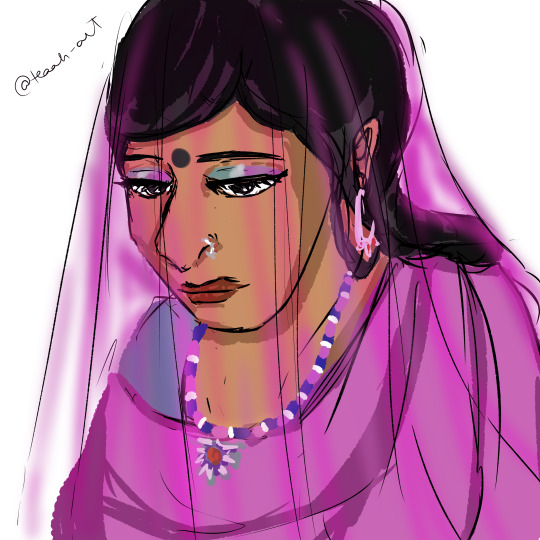
Desi LGBT Fest 2023 (hosted by @desi-lgbt-fest)
Day 2 : Legacy
Ghoonghat : A Portrait of The South Asian Third Gender
CW : Colonialism, Transphobia, Homophobia, Casteism
TW : Transphobia, Homophobia, Slur usage
South Asian history has ALWAYS been queer. We have ALWAYS had gender nonconformity as an integral part of our society. Yet, the modern Indian "conservative" view somehow points fingers to alleged western influence or modernization when it comes to queer visibility, fabricating a fundamental disconnect between South Asian culture and queer identities that was never supposed to be there. Why? What may have caused this mental divide? The answer might lie in systemic barriers built during the British Raj and the lasting consequences of that.
Third Gender identities such as the Kothi, Hijra, Khwaja Sira, Aravanis, and more are queer identities native to South Asia. No existing lgbtq label in usage in the Anglosphere describes them accurately and while 'Transgender' does serve as a viable umbrella term, it doesn't quite catch all the nuances. The term 'Third Gender' as a phrase does come close to distinguishing the identity as its own unique label, despite the term 'Third Gender' once again, being a western terminology tracing back to the 1860s which was once again proposed in a non-South Asian context and would still only serve as a broad umbrella term. Having said that, I will still continue to use 'Third Gender' to refer to these communities here because most of the names have been and do get frequently used as a slur. While much gets discussed in the anglosphere about slur reclamation in lgbtq+ spaces, South Asian queer dialogues aren't that well organized and not being a Third Gender person myself, I am hesitant and unsure of the appropriate use for community specific terms, which again vary from region to region.
History of South Asian Third Gender communities traces back to AT LEAST medieval era, if not farther back. While roots are hard to trace back and South Asian queer history may not be as linear and resolved as one may want to think, stigmatization of Third Gender communities along with other queer labels can certainly be traced back to colonial times. Section 377 of the British Colonial Penal Code, enforced in 1862 criminalized any sexual acts that were deemed 'against the order of nature' and was meant to systemically target homosexuality, sodomy, and any sexual nonconformity in the British colonies of the time. The Criminal Tribes Act of 19th and 20th century British regime in South Asia, that set out to profile hundreds of castes, tribes, and communities as 'hereditary criminals' (237 communities as of 1931), also included Third Gender communities and likely reinforced the queerphobia in society that Section 377 may have already established.
At the time of independence, when the Criminal Tribes Act was scrapped from the Indian constitution, but Section 377 remained. This means, as of 1950, you could legally present as a Third Gender individual, you could be in Third Gender communes in public and would no longer be arrested for it! But if you came out of the closet for say, being gay, or bi, you could still end up in jail. Not to mention that about 200 years of queerphobia, systemic queerphobia, does not change in a day despite legal reforms. So in 1950, when we were in a position where being gnc had legal immunity but being non-heteronormative didn't, Third Gender folks were put in a unique position where they could push for change. And push, they certainly did! I should note here that my discussion here of any legal reforms past 1950 would be limited to India since I am an Indian citizen and know Indian systems the best.
In 1994, India recognized Third Gender communities as a legal sex separate from the gender binary. This came with voting rights, right to contest in elections as a Third Gender person, right to legally LIVE as a third gender person, and more. On the state level, Third Gender activism ensured affirmative action for trans people not only for government jobs but also corporate jobs. Pension plans, welfare coverage, medical insurance, and even systemic changes towards establishing legal measures against gender discrimination. Despite the social stigma, despite their community names being used as literal slurs, Third Gender people have been at the forefront of every single South Asian queer activism and they have been WINNING!
I wish they got the recognition they rightfully deserve outside of South Asia as well. Current global queer activism is at a crossroads where trans exclusion has taken roots even in parts of the community. A lot of the exclusionary activism stems from the regimes and mentality that have a history in South Asia of erasing and colonising queer history. Is it so surprising then, that these regimes elevated bigots to power who further the same narrative they've been peddling since as far back as the 19th century? Shouldn't, then, Third Gender voices and activism inspire persevering and continuing to persevere against those very same barriers?
Third Gender erasure, reclamation, and activism is South Asian legacy, a story of resisting colonial structures, status quo, and systemic oppression. It is high time it gained visibility in international queer spaces.
Some articles to read under the cut (likely far more credible than my rant). Heavy TW for Transphobia and Homophobia for nearly all of the articles.
Shabnam Mausi - India's first trans Member of the Legislative Assembly (MLA)
The whole debacle with the 2019 Trans Rights Bill
The Hijra community and their plight during the pandemic
A Tamil Third Gender perspective on community labels
The Khwaja Siras of Pakistan and their legislative battles
A Bangladeshi ally's conundrum on what term to use for Third Gender communities
#desilgbtfest23#desi lgbt#desi lgbtq fest#third gender#long post#original art#my art#tw transphobia#tw homophobia#tw colonialism#tw transmysoginy#tw slur#tw queerphobia#ask to tag#wanted to post art ended up writing a op ed#in case you're wondering why I called it ghoonghat#ive never seen third gender people wear a ghoonghat cause it do b an artefact of usually conservative families#and imposition on daughter in laws#but south asian third gender activism gets swept under the rug so much#and has such less visibility#it might as well be thinly veiled#like a ghoonghat
70 notes
·
View notes
Text
Starry, Starry night
This new picture for the upcoming episode has been released, let's talk about it. Please remember, I live in delusion.
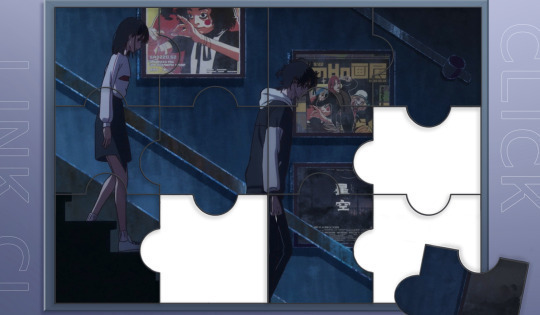
There are several posters on the wall, and the one next to Cheng Xiaoshi - 星空,refers to the film with the same title. Starry, Starry night is a 2011 Taiwanese drama based on a novel by Taiwanese author Jimmy Liao.
Hsieh Xin-Mei used to live with her grandparents up in the mountains. Then she moves to the city to live with her parents, but her family situation is not very good, and she tries to hide from reality in the world of her own imagination. One day, a new student was transferred to her school - a boy named Zhou Yu-Jie.
Despite the misunderstanding at the beginning, both of them are lonely and feel like outsiders in their own lives, befriending one another. When reality catches up, they try to escape to a world that belongs only to them, to see the stars. Do I have to tell you that this story is about grief and sorrows, "the end of summer", journey to adulthood, love across time and distance? About an accidental meeting and fate.
I think it's worth your time to watch, this film is very heartwarming.
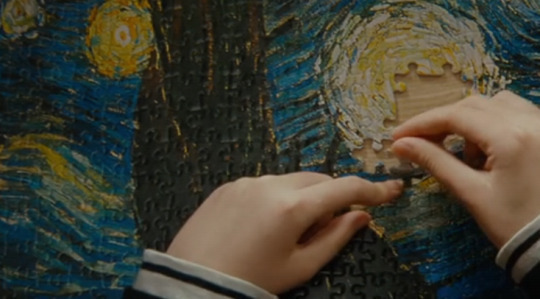
You can read the full plot description on Wikipedia, although it will not convey the full meaning, since the film has many artistic images and interesting decisions that convey the story sensitively. If you want to watch it yourself, read no further.
Spoilers … And References. And some beautiful moments that make me THINK.
1. Time
One of the themes is time, the hands of the clock often tick in the background, and at some point the numbers themselves, which indicate train departures, not just stop - freeze.
18:42 - 18:50 - 18:55
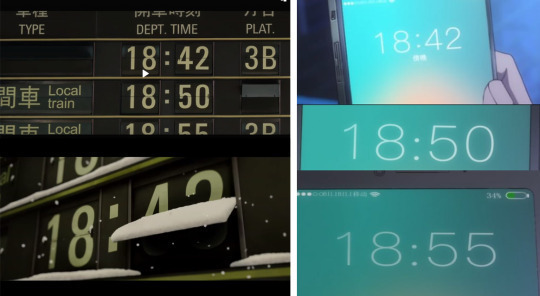
Do I believe in coincidences? No.
2. Journey
Their path - an escape to their dream world - passes through a tropical wild forest. On their journey, they try, despite the difficulties, to find the right path to their dream.

Since s2e1, I've been thinking about how much the forest in the back of that vision, ED/OP, is a real forest, a real tunnel, not the symbolism of the "journey". But now, if such a choice is not accidental, I have received answers to my questions, at some point.

In fact, I lost my mind at the moment when they came to a fork in the road, they had to choose their path - they took the wrong path, and were forced to face the same choice, choosing a path, for the second time. Again.
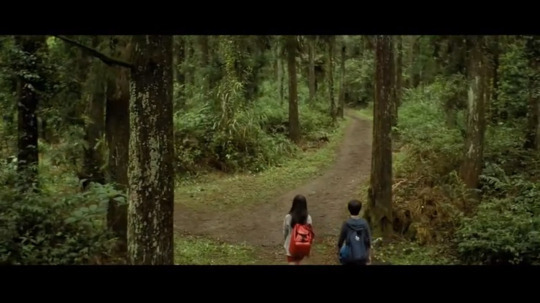
But in the end, the path to the stars ends in a life-threatening situation where they have no choice but "return". Although they both know that this is the end for them, the end of their journey, and the end of their "summer".

3. Puzzles
This story is about art, not about photography, but about paintings and puzzles. Puzzles literally act as moments of remembrance. Although these are not burning photographs, deep in her sleep, Hsieh Xin-Mei follows the image of Zhou Yu-Jie in the night forest, and the entire world also collapses when the end comes.
When Hsieh Xin-Mei woke up from her dream, Zhou Yu-Jie was no longer here.

The search for the missing part - the sun, on the puzzle based on the painting "Starry, Starry Night" - is fundamental, literally the core to the plot.
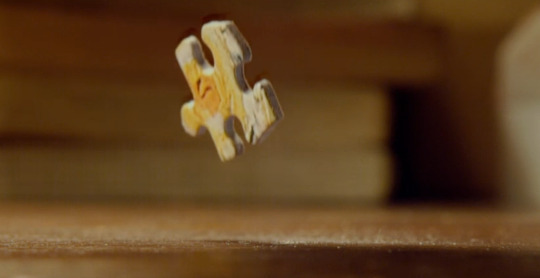
The connection of everything, through the years. It's like a promise, it's like an eternal memory of that time.
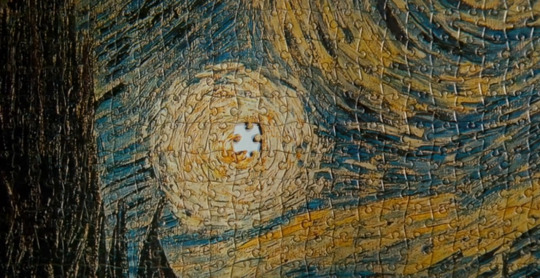
There are more things I could write about, but I don't want to make this post too long… Just. There is always something about stories with a sunshine-like person, curious, breaking boundaries, talking non-stop, and about a person who quietly looks at the first one, listening to everything with a smile. And it becomes life-changing.
I would like to remind you that these are just my thoughts, I'm having fun, maybe seeing something that isn't there. We will see anyway.
But. For real. Put a detail like that into an episode and expect me to ignore it? No. Huh.
I'm just overthinking once again, but Interesting choice :)
145 notes
·
View notes
Text
I've been thinking quite a bit about the NYT Taylor op-ed and the aftermath. And what it's crystalised for me is how difficult people find it to argue 'my belief is reasonable' without also arguing 'and everyone else is wrong and this is the only correct belief'. And how silly and damaging the second is within fandom - where you don't know and it doesn't matter.
I saw this screenshot about Taylor - and I'm posting it because I want to really encourage people who are approaching this logic to take a step back and understand that there is an alternative:

I don't think telling stories about Taylor is weird (or if it is it is weird int the glorious way all people are deeply weird). The first part of these statements is fine. But the second part is both obviously untrue and deeply fucked up; it is definitely not weird for straight people to write songs inspired by art their friends love, or draw daisies that look like daisies their friends have posted.
Speculating about which prominent people are queer is definitely part of queer culture - and I would argue that in that context it can be good actually. But within a fandom context it gets warped into something else very easily - and you can see that in how often people present themselves as fans start to argue that the only options for the person they're talking about are: Gay or Bad.
I understand that in this case people feel like the response to the NYT piece has suggested that they're bad and wrong (I would argue that the most significant response to the NYT piece is about it being in the NYT - and it's not relevant to what fans who are not writing in NYT are doing - but I can see that people feel differently). And they're choosing to respond to that feeling that they're bad and wrong by pushing those feelings on to Taylor
What if nobody had to be weird or wrong? What if it was really OK to see queerness in someone's life and work and not have to prove that no straight person would do so? What if there were other ways of dealing with something feeling shitty than proving that someone else was wrong?
As well as being pretty bad for the people involved, I think this drawing of lines is pretty incompatible with the joys and strengths of queer culture. Trying to make the line clear and insisting that no straight person would ever do X - is actually leaving less space for queer people in general - and closeted queer people in particular. A lot of queer culture is about making space within that ambiguity - and I just don't think that ending that ambiguity - demanding clear lines and bright lights - is good for queer people or queer culture.
#oh fandom#One thing I'm really interested in#is why and how fandom as experienced on line#is such a rapid creator of boundaries and lines#I do think at it's core it's about anxiety and the way people's anxiety responses are reinforced
15 notes
·
View notes
Text
New hypmic anime season and I'm BACK IN THE FUCKING BUILDING AGAIN (I feel like the Martha I'm coming home sweetie audio)
Thoughts on the 1st ep of Hypmic Rhyme Anima+. Spoilers beware
New plotline lets gooooooo
I like that they're straying away from the drama tracks actually, Rhyme Anima is fundamentally a different experience from the core drama tracks which gives new material for both new and old fans
OP is an actual banger, Ramuda's verse is the best fight me all you want but you know i'm right
Nemu!! uh spoiler chara for anyone new to the anime I guess? Like they spoil her right at the introduction and iirc they didn't really build off her mystery in the first season. Makes her impact here a bit weaker but I'm willing to let it slide since some might not catch it
(Post Editing Astro here: I haven't rewatched Rhyme Anima since it finished airing and uh. Nemu definitely was a plot point there lol they dropped it after ep 11 but she was there!)
Jyushi my son I love you so much you idiot
I love the little stingers for each team that they did for each team, its so cute and gives so much personality
The visuals have definitely improved, a big step above the last season in terms of animation
i don't see an improvement with story writing though… Pacing is still all over the place and very squished/fast paced
makes sense since the cast has grown by a quarter since last season but still makes me sad that there isn't much time given to each character individually
I forgot how much I love the localization of Doppomine
Okay so Pink hair and Green hair in the flashback are most definitely the two in the white cloaks. Theres just no subtly with this series lmaoooo
Nice that they were able to incorporate everyone somehow but too many people means that too many parts to handle
I'm getting deja vu, this exact same thing happened last season….
Oh. Its the same guy. Makes sense lmfao
Listen bud I have minimal rap experience but that rap was just embarrassing wow. No rhyme or flow, there was only straight passion which i mean props I guess but you suck ass
Look at me being so smart and predicting all of these ahead of time without looking at any materials
Did Rio just contact Jyuto with his hypmic????
Samatoki have I ever said that I love your for being a bullheaded idiot? bc I do. you're so silly
Damn the typography has gotten even better, its just a lot more smooth and the animation too especially during Jiro's part is just so stylish
The animation has improved a lot I'm glad it got a little more love compared to last season
My guess is that maybe someone from the six divisions will fall under the anger thingy that's going around, something like the stage show. My biggest guess is that they might re-incite the Samatoki and Ichiro conflict again but I hope not. Another guess is that there will be old MCD or Naughty Busters beef which seems more plausible given that this is Sasara and Kuko's anime debut but I guess we'll wait and see
THE OUTFITS!!! THE STUPID OUTFITS I LOVE THEM
the art style of the ED is super pop punk and has a strong sense of style which i love. its simple but stands out really well which i love
Very jjk but more toned down. Feels a bit like a cleaned up croquis drawings
the smear frames is just so stylish and good, very simple and a bit messy and sells the gesture drawing kind of feel of the ED
Ramuda's parrot costume i love you
Those hand signs just make the first letter of each word which is really fun. Not proper JSL though I guess beggars can't be choosers esp for a series like this
Overall, a really strong start. It shows how it built off the first season and where it improved and while some things (like the horrid pacing) never change, at the end of the day its still a fun and delightful watch
If anyone wanted to read my thoughts on the first season, they're all archived here
#hypmic#hypnosis microphone#Hypnosis Mic: Division Rap Battle: Rhyme Anima+#hypnosis mic rhyme anima
8 notes
·
View notes
Text
Hikari no Ou - Episode 1 - Thought Post - SPOILERS!

This first episode did a great job of balancing it's exposition. There was just enough showing through moments like Touko looking at the goddess statue or Rin wearing the mask and watching Touko leave.


But at the same time, we got told about certain aspects, which explain more of the "rules" of the world they are living in. They knew which things needed to be shown and which things needed to be told to give us a good balance, and then we also got excellent moments like when Touko had the lantern, and Rin tells her she is wasting the "fire" that she had. That scene also had Rin stating quite bluntly why she hates Touko.
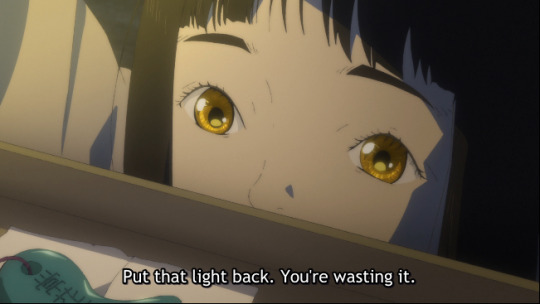
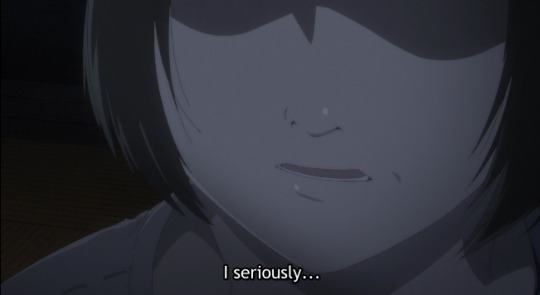

Both of these bits of information are then reinforced through later scenes, like when we see the machines arrive with the fuel and the abovementioned scene with Rin and the mask. It helps reinforce the world building, adding proper layers.
I also really enjoyed the small detail stuff like how this society has started naming their children using fire and red related terms as a way to bless and protect them from real fire. That just seems really realistic. Also, the narrator makes it clear that the past used to be more "modern" and we can still see remnants of this in things like Koushi's umbrella and a girl in the city wearing a more Western style outfit.

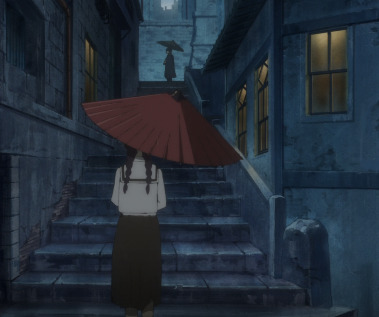
When it comes to the visuals, mood, and atmosphere, I almost got a bit of an Ookami vibe to it. The music, I think, really helped in this area to provide a feeling of a modern day folktale or lore, but with touches of more modern technology, which is an interesting mix. The art style also has this slight sketchy look to it, which also fits in with that whole atmosphere and really does make the series feel like a novel, which this is based on (iirc) come to life. The imagery in the ED really highlights this as well (the visual and colors almost remind me of Mononoke (the 2007 TV anime series) too:

The use of light and weather to set mood is very nicely, and subtlety done. As are the simple transitions and small moments dedicated to the nature and scenery. They all help with the world building and setting the appropriate mood:
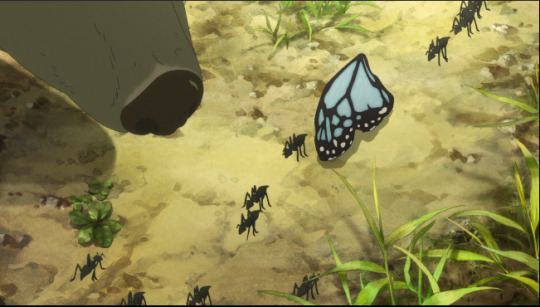
The short, brief black screens with the name of the focused character (first Touko and then Koushi), combined with the OP imagery like this:
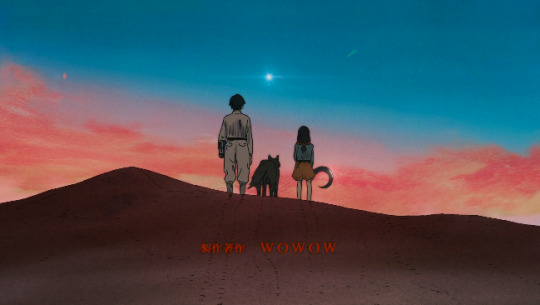
Makes me think that we are getting a dual protagonist approach, with one male and one female. I really like approach (that’s an aspect of Fruits Basket that I always enjoy). I look forward to seeing if their two stories will end up meeting. I feel like they must.
The voice acting is also great in this series. Very natural sounding, which I personally tend to enjoy more over more...animated voice acting. The more produced and fake sounding stuff found in most anime series, tbh. After having lived in Japan and hearing natural spoken Japanese, the way Japanese is often acted and spoken in anime bugs me a bit more nowadays. I can ignore easily enough when I really enjoy a series, but finding one that doesn’t rely on that too much or often is a breath of fresh air.
The last thing I want to comment on is the character writing. This first episode did a very good job of simply establishing the characters. From the way the papermaker talked about Touko, we can get a sense of how the village, as a whole, likely feels about her right now. From the grandmother's brief words about Fire Hunters, we can get an understanding of how the world these characters live in view that line of work, and from the two men's brief interactions with Touko on the machine we can see their difference in approaches to Touko (a gentle, soft touch approach vs a hard love type of approach).
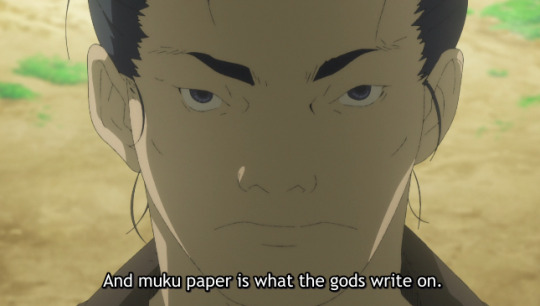
We also have some extremely good female character writing with the aunt. She has a stern look about her and knows how to use that, as well as her knowledge of the world, to get the paper that Touko would need from her journey. She is never shown being intimidated and is very intellectually bright. But, we also see her being very understanding and gentle with Touko over the mistake Touko made.
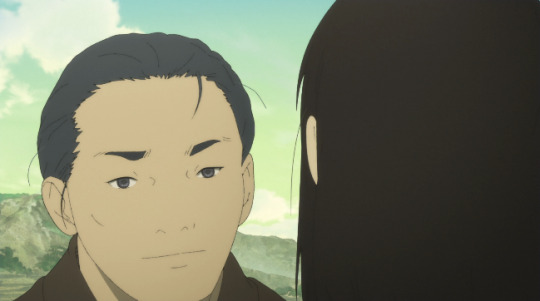
This is a great level of complexity for a female character, especially for one that may not even being a returning and major character. It leaves me feeling very hopeful about Touko's future growth and development as a character too. It helps that I also think they did a good job of showing how she is a nice and kind girl - respectful - but she is determined to make amends for her mistake and won't back down or show fear, even when it is made clear that she may die on the way to the capital. There a solid foundation for her character, with room for her character to grow and develop a more distinct personality along the way. I am really excited and interested in seeing that!
#Hikari no Ou#The Fire Hunter#Winter 2023 anime#anime#thought post#long post#Hikari no Ou spoilers#The Fire Hunter spoilers#HnO spoilers#TFH spoilers#image heavy post
4 notes
·
View notes
Text
character study;
mitsuki bakugo | timeline
tw mentions in tags & end of post;
constrained to after read more
age four: in the dramatic world, quirks present themselves with magic / with physical changes / with loud announcements. at age four, there is nothing obvious from mitsuki. no dramatic changes, nothing. babyfat rounds her cheeks, & her skin shines with youth. her quirk is only confirmed through scattered doctors’ appointments —- mitsuki is not quirkless. but there is nothing about her that screamed power.
except her lungs. she’s got enough fight in her to last a century, &
it didn’t really matter to her parents. her having a quirk felt like the bare minimum. her father ( souta ) likes the idea of acclaim & glory; he fell short of his own standards. in his youth, he had a potential career in baseball. a knee injury lowered his chances & then things happened & things happened & things happened —- he winds up working an office job. granted, he likes his work in journalism. critiquing & fact-checking politicians & writing all sorts of op-eds . . . but he likes even more to think of himself as accomplishing something. who doesn’t? his kids are supposed to be a part of his accomplishments. & in the process . . . he believes ( a little obliviously ) that mitsuki is fated to be someone gentler. & with such a subtle quirk . . . he has no reason to change his expectations.
her mother ( aki ) is a quiet woman who believes deeply in the art of self-restraint. she is a nurse, the daughter of a military man —- she never particularly wanted to be a nurse, but . . . she likes to have a purpose. she believes strictly that it is within her capacity to tolerate anything. she is rarely impressed, & she is easily unimpressed by her homelife. although she does not imagine herself to be the head of the household, she has her specific expectations.
age six: no one at school knows what the fuck glycerine is. neither does mitsuki. all she knows is that if it’s super hot outside & she runs around a lot ? she can lick her wrist & it tastes a little sweet. it’s like a party trick.
age seven: mitsuki’s youngest brother is born. something isn’t right. something isn’t right. her mother won’t quite look at the baby; aki stares a lot at the wall & can’t sleep. aki snaps at souta who bites back & still won’t win. it frustrates him, & he makes mitsuki try & hold her brother. she’s young, so she delights in the privilege of holding a baby but . . . it doesn’t occur to her that he only tells her to do it because she’s the only other girl in the house.
something isn’t right, & mitsuki’s mother seems restless & listless. it lasts months. mitsuki doesn’t forget it. souta does.
age eleven: mitsuki thought she was in love. she wasn’t. it was fucking puberty.
the same year, her brother ( 2 years older ) breaks out for the first time. mitsuki laughs. her brother whacks her in the head with a pillow.
age fourteen: souta loses his job. the newspaper shuts down, & aki pays for the family. & souta decides that it’s time to drink —- which aki hates & hates & hates. there is no self-restraint in that behavior, she decides. it’s not what she expects of her household, & so she nitpicks her children. mitsuki is an easy target because aki imagines she sees bits & pieces of herself in her daughter. not that it matters.
mitsuki spends nights teasing her brother about his girlfriend. he doesn’t think her jokes are funny, & they can hear their parents arguing in the next room. souta is the main person yelling. aki doesn’t like to yell. she has too much self-restraint.
age fifteen: souta is still out of a job. puberty is a bitch, but mitsuki’s skin is pristine. she tells only her friends that she avoids blips & beeps on her skin because of her quirk —- the rest of those suckers can think she comes by it naturally. which . . . in a way? she does.
souta hasn’t found a job yet. he’s still drinking, but now he’s drinking with friends. he invites friends over to play & boasts about whatever he can. including his sons’ accomplishments, about his wife’s cleverness, about mitsuki’s . . . mitsuki. she’s growing up nicely, isn’t she? she feels like the friends leering. they’re leering. & her father doesn’t care.
she gets drunk for the first time at a party. her mother finds out when she she comes home too late. aki chews her out; it’s easier to reprimand mitsuki than it is her husband.
mitsuki gets drunk again when she’s
age sixteen : her father gets a new job. they move. life stabilizes again, & mitsuki breaks her ankle.
she gets a job at a friend’s family restaurant. she doesn’t really have big dreams for herself or anything, but she likes to imagine she can be a forceful enough presence to make something happen.
age eighteen: mitsuki has a bad relationship, if you can call it that. souta doesn’t believe her. aki thinks she probably is to blame, since mitsuki is a bit wild. there’s a bit more to it than that.
she hates it she hates it there’s a lot of empty anger & some laughter & then silent days & then inbetweens. lots of inbetweens.
she gets a roommate & moves out of her family home.
she finds some part-time work modeling ( look at that skin ! ) —- she does it to network. she’s determined & a little furious at nothing. most of her jobs are for outdoor / athletic apparel.
she becomes an aunt for the first time.
age nineteen: she doesn’t remember all of it, but it feels good to live away from home. she has a miscarriage ( she didn’t know she was pregnant ). mitsuki copes with ups & downs.
& she’s working two/three jobs until she manages at
age twenty: to get an assistant job at a design firm. there’s still the occasional modeling job, & she’s a little embarrassed by most of her work. but she likes working at the design firm. she likes
that one guy. who’s stupidly polite & looks a little judgy & a little nervous . . .
he learns so much about her, & it’s disorienting. she tells him more.
age twenty-one: they’re engaged. . it’s a lucky thing, too, because they’re engaged five months months before they learn she’s pregnant &
she goes traditional for their wedding for the sake of her mother-in-law. the wedding is fine & good & charming but doesn’t eliminate how
it’s terrifying. positively terrifying.
even more so when
age twenty-two she realizes with the birth of her son that it’s possible to love something/someone as much as this.
& then & then & then . . .
nb; nothing is described explicitly. tw for alcohol, miscarriage, harassment, & implied ipv,
#120. mitsuki#5. headcanon#6. drabble#i guess it's kinda a drabble sfg#tw alcohol#tw miscarriage#tw harassment#tw implied ipv
10 notes
·
View notes
Note
When MVA/MLA Arc gets animated, what will you be looking forward to the most? What (canon-compliant) additions and/or changed do you want or think Bones should make, if any?
There’s--a lot. Does that surprise anyone? There’s a lot.
o I have been foaming at the mouth for voice actor announcements for almost a year now, particularly for Trumpet, Geten and RD.
Trumpet’s superpower is literally his voice! I mean, nothing about that statement requires that voice be particularly entrancing, but it certainly seems like it should be, right??
Geten is a boku-type in the manga, but that was literally the only hint foreshadowing his pretty boy face through 21 solid chapters of Pure Feral Gremlin. Everyone was shocked by Geten’s face reveal! How do you maintain that surprise value with an actual voice actor in the mix? Do you not even try? Do you play up the disparity--in which direction? I can’t wait to see what they do.
And Re-Destro! Re-Destro requires so much range! From his peppy, silly businessman persona, to the urbane commander, from the overeager yes-man to the raving zealot--who on earth do you get to believably cover all that ground? I can’t even begin to guess, but I am living in anticipation of that article going up on ANN or the official Twitter sources.
o I’m also much looking forward to getting official coloring on Trumpet and Geten. Skeptic seems pretty straightforward--black, black, more black--and RD and Curious, we have color art for, but I wonder if Trumpet will also be all black clothes, to go with that dignified politician image of his, or if he’ll get some color to pep him up a little. What color are those tinted shades of his? His eyes? The wicked-cool Sevens Loud?
I assume Geten is all wintery shades, but it’ll be great to confirm which ones. I mean, we all assume he’s white-haired to better annoy Dabi with family parallels, but what if he turns out to be platinum blond? And are his eyes blue? Gray? White? What color is that awful parka?
Also, Re-Destro’s stress powers. Having been writing them as black since at least August--Rorschach test blots are generally black, after all, and they’re the clear inspiration--I would much like it if the anime would have my back on this. They made Destro’s mask a dark cinnamon brown, though, so I’m prepared to be unpleasantly surprised in this matter.
o Predictable MLA adaptational choices aside, I’m also eager/anxious about how they’ll handle Spinner’s narration. What I really hope is that they actually straight-up hand him ALL the narration duties--not just the stuff he dictates directly in the manga, but also e.g. the name and quirk explanation material that Present Mic normally gets, or the previews that are always handled by Deku.
The opening and closing sequences are another big structural thing, of course--based on the flashed snippets of Hawks and Endeavor in both our current and the previous OP, I’m expecting we’ll see at least a bit of something referencing the upcoming internship arc (which I expect to close out the season), but I hope the villains just walk away with the closing entirely. I want my slice of life villainy ED, dangit.
o Another thing I’m eager/anxious about would be Kotarou, and the Shimura flashback generally. There’s a brittle edge of to Kotarou that I really love, and I hope he manages to keep it in the anime, despite the anime being generally not so great at moments that I would describe as “delicate.” For example, I’d like it if he doesn’t get a super deep voice, and if they could manage to keep his pretty face, and capture how deeply bitter and tired he looks in the scene where he’s reading the letter Nana left him.
Also, I hope they keep the little montage bits and, crucially, the changes of clothes the family goes through. We see Tenko in no less than five, possibly as many as seven, different T-shirts through the course of that flashback. It seems like a small thing, but it’s one of the factors that makes me skeptical that AFO gave Tenko Decay, when so many days clearly go by between the opening with the man at the door and the tragic end. It’d be nice not to see too much resurgence on that just because the anime can’t be bothered to come up with more than one outfit for the Shimuras.
I have enough issues with the anime’s usual adaptation choices that I’m trying not to get my hopes up too high on the actual content of the episodes. The staff is diverting too much of its major talent to the movies (BAH) these days for me to expect the whole season to look all that great, and it’s never been particularly creative or daring outside of its climactic sakuga-heavy fight scenes anyway. I’ve also long had a bone to pick with its scoring decisions, and am already eyeballing the climax of the RD/Shigaraki fight and imagining the minor-keyed terrifying dirge I fear the anime will play there, at the moment that Re-Destro (and, shortly afterward, Spinner) are supposed to be experiencing something akin to religious awakenings.
There’s also the issue of the violence and gore--judging by how the anime handled the scene where Shigaraki and Compress maim Overhaul, I have some severe reservations about how much blood they’ll be allowed to get away with, particularly in the scene where the League brutally decimates that CRC group and, of course, Shigaraki’s backstory. I’m looking at MVA to serve as a preview for how all the same issues will be addressed in the War Arc.
That bit of pessimism aside, as to what I’m hoping they’ll add or change? Well, off the top of my head.....
o I would love to get a full episode devoted to the time the League spends fighting Machia. Not that first tussle, but the six grueling weeks in the mountains. There’s so much you could add there for character building and atmosphere that Hori didn’t so much as montage through. Where was their food coming from? How’d they pick out places to pitch camp? How much access to news from outside did they have, and how frequently? What were the circumstances in which Gigantomachia “told them himself” about his great sense of smell?? Stuff like that!
I don’t think we’re at all likely to get this--honestly, the series of late has had enough of a problem with trimming bits and pieces that I’m as worried about what they might cut as I am hyped about things they might add--but the one thing that gives me some hope is the training camp arc. Specifically, the moment 1-A first gets to the Pussycats’ forest, they get jumped by earth golems, a fight that the manga off-panels entirely, but the anime spends a modest amount of time on, giving the kids a little bit of time to show off their moves and such. I’d love to get something equivalent for the League.
o On a similar note, I wouldn’t turn it down if they fleshed out some of those running street fights a bit. One obvious thing comes to mind: there’s a weird jump in the manga between Skeptic and a horde of his golems being all but on top of Twice at the beginning of 233 and then that fight just--doesn’t happen. There’s no mention of it at all. I think the suggestion is that either Machia’s appearance or the tower going down interrupted it--Skeptic breaks off from his fight the same way Geten and Trumpet do theirs, shifting focus to protecting Re-Destro--but it’d be nice to see the anime touch on it.
o It’d be nice to get a bit of expansion on the nature of the bullying Spinner endured. We’re told he was, but was it limited to verbal? Did he get beaten up a lot? Was there an online element? Deku’s our only other reference point for “bullied kid,” and whatever one might think about the story’s development of Bakugou’s mentality, it’s been made clear in retrospect that there was a lot more too that than just the matter of Deku’s quirklessness. I’d love to know how Spinner’s bullying looked in comparison (not least because of some of the theories about Spinner and Deku needing to come to some kind of accord to free Shigaraki from AFO).
o Make the Villa (both here and during the War Arc) look more realistic. By which I mean, I know Horikoshi is capable of drawing interesting and lived-in interior spaces--he has an entire chapter dedicated to it in the 1-A dorm room contest, after all--but he normally doesn’t bother much with it. At UA, it’s not too distracting, because we know good and well that that whole building is probably maintained by Cementoss anyway. Ditto places like Tartarus (intentionally, dehumanizingly barren) or the League’s post-Kamino hideouts (abandoned homes and industrial spaces). But the Villa?
For heaven’s sake, it’s called a mountain villa. It has a clear reception desk on the ground floor; it’s obviously some sort of high-end hotel, if not an outright resort or rentable retreat lodge. Speaking as someone who’s worked in one, places like that don’t look as fuckin’ bare as the rooms we see there always seem to. For fanfic purposes, I’m happy to go on telling myself that e.g. the pool and the bar and the restaurant(s) and the gym are in the building Cementoss doesn’t tear in half, but it’d be nice if the anime could class the whole place up a little, maybe put some real furniture and decor in the rooms that are in use. (Yes, I know this is a ridiculous nitpick.)
o This is less a change and more a correction, but for fuck’s sake, BONES, give us white-haired Shigaraki. The climax of Deika is a solid time for it, given that it’s obvious in the manga that Shigaraki’s hair gets paler in Deika--you can see it in the way Horikoshi inks it (which is to say, the way he stops inking it)! I think if we ever get white-haired Shigaraki in the anime, a somewhat better time as far as narrative justification goes would be when Shigaraki gets out of the tube in the War Arc; you could easily justify it as a side-effect of the surgery. Still, I’d rather see it here. I want white-haired Shigaraki, gleaming and brilliant through the scattering ash in that crater, a veritable angel of sacred destruction.
Honestly, more than anything, the crater sequence is the one I hope I love. It’s probably my favorite single moment in the entire manga, as Shigaraki wins over Re-Destro, Spinner and Gigantomachia in the same moment, and finally comes into his own. If they can at least nail that, I’ll consider myself pretty satisfied.
#stillness-answers#my villain academia#meta liberation army#boku no hero academia#bnha#hopes and dreams
15 notes
·
View notes
Text
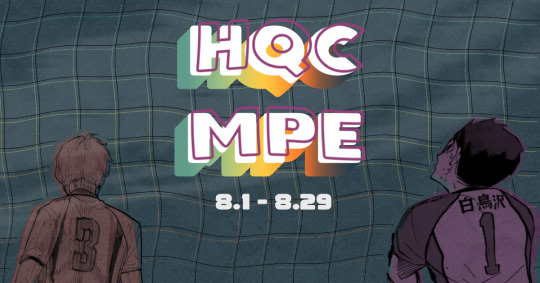
Welcome to HaikyuuCreations’ Monthly Prompt Event!
This is our very own event for all creators to create pieces inspired by the given prompts. At the end of the event, we will put all pieces into a randomizer to choose two winners. The 2 winning pieces (one written and one visual) will be announced on August 29th at 12PM EST and will be promoted on the blog until the end of the next monthly event.
ACCEPTED PIECES
scenario (at least 500 words)
social media au (at least 5 images, not including profiles)
headcanon (at least 100 words)
artwork (original art, recolorings)
edits (gfx, gifs, video edits)
RULES
This is a open event
Event is open from August 1st to August 29th
Entries can be any genre or pairing
Entry must use the event hashtag: #haikyuucreations 0820
Must state your given prompt within your post (beginning or end) and clearly implement it in your work
Use at least 1 prompt but no more than 2
You’re allowed to use a visual prompt for your writing entry or a writing prompt for your visual entry
WRITING PROMPTS
Below are the prompts you can choose from! You can use the OTP, dialogue prompt, or both as long as you follow the given theme. Be as creative as possible as long as the prompt is the central focus of your writing piece.
1. Obon Week — The Bon Festival, or Obon Week, is a Japanese Buddhist custom lasting three days to honor ancestors. Celebrations include carnivals with rides, games, festival foods, and dances and lanterns to honor the ancestors. Festival goers try new foods and spend time together to make new memories while revisiting old ones.
Prompt: A asks B out on a date to the carnival. They decide to ride the ferris wheel, which ends up getting stuck, with the two of them at the very top. “Did I mention I’m deathly afraid of heights?”
2. International Hangover Day — August 8th is International Hangover Day, just a day after International Beer Day. The day previously was such a blast, though anyone can hardly remember it, but now your characters are suffering the consequences.
Prompt: A massive headache, nausea, and dizziness has overtaken A’s body, and B can’t help but try to help them through their hangover. “I’m going to throw up.” / “AH! Can I hold your hair? Get you some aspirin?”
3. Sweater Weather — As August rolls around, temperatures begin to drop and it’s time to break out the sweater paws. Leaves darken, and sometimes relationships do too. Whether it’s cuffing season, school season, or festival season, this is the season of changes.
Prompt: As the chilly weather rolls in, A notices that B is shivering. A can’t help but take both of B’s hands into the long sleeves of A’s sweater to warm them up. “It’s too cold, huh? Do you want my sweater?” / “Are you cold? Can I hold your hands to warm you up?”
VISUAL PROMPTS
4. Endings and Beginnings — The number 402 symbolizes a new challenge. For us, it’s the endings and beginnings of phases and cycles in life.
Create a visual surrounding the start of Haikyuu!! vs. the end of Haikyuu!!
5. Color Palette — Draw your favourite character, Haikyuu!! OC, recolour a panel, or create an edit/aesthetic using only the colors from this palette.

HEX: 233D4D, FE7F2D, FCCA46, A1C181, 619B8A
6. OP/ED Lyrics Prompt — Create a visual with either of the given lyrics as the reference (Choose one of the two songs).
Imagination —
“There’s a blinding haze of heat
My heart nearly skips a beat
I get lost in the moment ‘til you pat me on the back”
Fly High —
“The flame that always burns the inside of my heart,
becomes the lighthouse to illuminate my way
The beam of light at dawn would make the flower of talent bloom, so
Until your life comes to an end, exceed your limits and at the highest speed,
Fly, fly; fly high”
77 notes
·
View notes
Text
I just finished writing up my voter slate for my family and here is the full text of my analysis of California Prop 25. This includes an explanation of some of the history behind Prop 25, which wasn’t included in my previous post. You can click the read-more (and scroll past the numbered list) to get to that part.
Prop 25 (replace money bail with a racist algorithm from hell): VOTE NO.
Okay. This one is a big deal. Part of the reason my slate is so late this year is because I would not release it until I had finished researching Prop 25. I was also waiting for a couple prison abolition groups whose opinions I value to take a position on this prop. Most of them never did. The Ella Baker Center, who has done extraordinary work this year in the Stop San Quentin Outbreak Coalition and whose opinion I particularly wanted, has just released their slate and they are neutral on 25.
The sources I ultimately based my decision on were the League’s reasoning and—even more so—Justice LA’s position paper.
(Also worth checking out: this Op-Ed by Bobby Stein in the SF Chronicle.)
This is a summary of the points from both sources that I consider the most significant.
Prop 25:
Is likely to drastically increase the number of total people in jail at any time; LA county estimates their pretrial detainee population will double if it is passed.
Puts money into the prison-industrial complex rather than taking money out.
Offers no way to appeal a judge’s algorithm-based decision on keeping you in jail, no transparency into how the judge comes to that decision, and no way to get out of jail before trial once it’s been made. Like, it replaces bail, which is of course corrupt and awful, with unilateral pretrial detention with no recourse. Which is worse.
Uses inputs for its flight-risk algorithm that are abjectly racist and which include—this makes me lose my mind—residential stability.
Co-opts the increasingly powerful movement to end money bail. Basically, if we don’t pass 25 I truly believe we have the momentum to demand something better. If we do pass 25, I worry that repealing it will be much harder.
Full disclosure: Prop 25 is on the ballot because the bail bond industry put it there. It’s a referendum on legislature that—without that push from bail bond companies—would already be law. Putting Prop 25 on the ballot and getting you to vote no on it is a last-ditch effort by bail bond companies to keep their industry from dying. Believe me—That doesn’t sit any easier with me than it does with you.
But. SB 10, the law that Prop 25 gives us a referendum on, is a hellish nightmare. It’s masquerading as bail reform, but it’s an expansion of the prison-industrial complex. It capitalizes on the movement to end money bail but it does not serve the interests of that movement (i.e., justice, liberty, basic common sense.)
According to Justice LA, “In 2018, led by Black and Latinx communities, Californians demanded reform of the bail system that held people in jail pretrial and worked to pass a bill that would advance freedom. Just days before the vote on the law, Senator Hertzberg, with opportunistic “reform” organizations at his side, substituted a completely different bill that he created with judges and law enforcement. That bill was SB10.”
SB 10 passed. And then the bail bond industry poured millions of dollars into putting a referendum onto the ballot, in the form of Prop 25, giving us a chance to strike it down (by voting NO on 25.) Every part of this story sucks; and neither of our options are good.
The SF League of Pissed-Off Voters wrote a sentence that sealed the deal for me, which was: “We can't support any bail reform policy that doesn't protect the constitutional guarantees of due process and presumption of innocence for people caught up in the criminal justice system.”
I agree. A law that writes away the right to due process is unacceptable. I hate money bail with a passion, but please vote NO on Prop 25.
Sources I care about that said Yes on 25: Harvey Milk LGBT Democratic Club, SEIU Local 1021, The Bay Guardian, SPUR, Cal Nurses union, San Francisco Tenants Union, SF Labor Council, California Federation of Labor, California Federation of Teachers, PICO California.
Sources I care about that said No on 25: The San Francisco League of Pissed-Off Voters, No Justice Under Capitalism, California NAACP, various individual human people whose advice on criminal justice policy I deeply trust, and the Justice LA Coalition, which includes:
Arts for Incarcerated Youth Network, Bend the Arc, Color of Change, Communities United for Restorative Youth Justice, Dignity and Power Now, Encode Justice, From Gangs to Glory Opportunities Foundation, Frontline Wellness Network, Human Rights Watch, La Defensa, Local 148 - Los Angeles County Public Defenders Union, Los Angeles Community Action Network, Prevention at the Intersections, Project Rebound, San Bernardino Free Them All, Silicon Valley DeBug, Stop LAPD Spying Coalition, The Coalition for Engaged Education, University of California Cops Off Campus Coalition Faculty Committee, Youth Justice Coalition, White People 4 Black Lives, Riverside All Of Us Or None.
Neutral: Chesa Boudin (San Francisco’s super-progressive D.A., who ran primarily on an abolish-money-bail platform but said he cannot endorse Prop 25 or SB 10 in their current form); the Ella Baker Center.
People whose positions I wanted to consult but could not find, probably neutral: CURB Prisons; Legal Services for Prisoners With Children (although the fact that Riverside All Of Us Or None, which I understand to be a local branch of the grassroots arm of LSPC, says No on 25 may speak to their position); Survived and Punished. If I find positions from any of these groups before Nov 3 I will update this post.
Addition:
Here is a position statement by Silicon Valley DeBug explaining that they helped co-sponsor the original bail reform bill that got mangled into SB 10, and they now refuse to support it. Relevant quote:
“This letter is to inform you that Silicon Valley De-Bug will no longer be a cosponsor of SB10, and are opposing the bill...the final version of SB10 is a complete departure from the original, and is antithetical to the principles of freedom and equal treatment that originally brought us into the legislative discussion.”
36 notes
·
View notes
Text
A Bleach Retrospective: In defense of Bleach
These are opinions, please respect that.
_______________________________
My Journey with Bleach (please skip if you want to go straight to the analysis):
On September the 8th, 2006 YTV’s weekend evening anime programming block (Bionix) aired the first episode of Bleach. I, unfortunately, did not catch this episode, instead, I caught the second episode on September 15th the following week. I was ten and from then on, Bleach fascinated me. It had an interesting concept, tight pacing, catchy music, a good story, and unique character designs. I also really enjoyed how Bleach lacked the same kind of emotional labour that Naruto demanded (as child who survived off of constantly seeking validation from others because of absentee parents, Naruto is way too much work).
My fascination with Bleach got me started in the fandom communities of yesteryear, for I was a child with zero internet supervision. My introduction to fanfiction was because I loved Hitsugaya Toshiro.
Bleach was my entry into poetry (poem at the start of every volume).
But alas, all good things were not meant to last and by the summer of 2009, I was officially done with Bleach. It had felt stilted for some time before then. Over the years, I would gradually revisit bits and pieces of Bleach, but I would not read it in its entirety until months after its finish, about a decade after I had first saw Bleach on my TV. Between the time I stopped reading and the series ended, I became friends with people who didn’t think highly of Bleach and I also started seeing criticism I had made about Bleach in 2011 being repeated by fans on the internet, I started to think that maybe Bleach was bad, but I knew what bad writing looked like —I started reading fanfiction through Bleach fanfiction AMVs on YouTube — and somehow Bleach didn’t sit right with me in the “bad writing category”.
I sit back now, a decade and ahalf later from when I first started and ask, “was Bleach really that bad, and if so, why do I keep coming back to it?”
-----------------------------------------------
What Made Bleach So Good?
Unique story and aesthetics: When Bleach first started in 2001, it was one of the first manga series to talk about souls and death in a poetic way and with such coherence. Bleach clearly knew what it wanted to say about life and death. It also had a very unique aesthetic, very similar to that of “The World Ends With You” or “Persona 5″ — an urban Japanese take on R&B kind of vibe. Also, Bleach had the most “realistic” and minimalist art style amongst the Big 3.
Cool Music: Bleach had cool music, from very solid rock’n’roll and R&B style songs in its OPs and EDs to very funky OST music with lots of pizzazz. Many singers feature by Bleach ended up successful (to varying degrees) outside of anime, eg: Orange Range, UVERworld, YUI, sid, etc.
Versatile tone: Bleach was edgy, there’s no doubt about that. It was willing to show a lot of blood and bodily violence, especially in the manga (eg half of people blowing up and bits of bone still attached). Despite this though, it was not pretentious about its edginess — it didn’t revel in it. To contrast the edginess, there is a lot of humour in Bleach with character interactions. It was able to be laid back enough with its strong characters that it would rely on the characters’ relationships for comedic relief. The post-credit skits and the fillers really helped to add to this overall feel as well.
Maturity of the Story: Bleach was very willing to handle topics that made people think. For example, the Ulquiorra - Orihime subarc was treated with a sense of carefulness about it, as if to reflect Ulquiorra’s own cautious curiosity about the heart. A less emotionally mature story would’ve gone for the cheap rape/torture porn, but instead we are treated to determined strong Orihime, who has found strength through the heart after the death of her brother, clashing with the nihilistic hollow who wants to know if there is happiness outside of emptiness. It’s a very loaded question and one that requires both perspective and life experience to fully understand both parties. As well, Bleach always knew what it wanted to say about life and death as the final conflict of Bleach is between Ichigo, who has accepted his transient life and Yhwach, who is scared of death. And ultimately, underneath all that action, Bleach produced takes on its themes that were hard to relate to unless the reader themselves had a certain level of emotional maturity (eg: 12 year old me got nothing out of the Ulqui-Ori arc, but 20 year old me spent a good 10 mins crying after)
Strong characters: Contrary to popular belief, Bleach does have quite solid characterization. In fact, Bleach is the journey of Ichigo as a character, from grappling with his weakness and pain to finally accepting all the parts of himself and his history in order to defeat Yhwach and protect those he cares about. Even the secondary characters of Bleach receive a sizable amount of backstory and/or development. Bleach also managed to have more proactive female characters. Even the damsel in distress Orihime stands up to Ulquiorra and slaps him. As a result of these strong characters, Bleach was able to rely on them and their relationships to drive aspects of the story (eg Ichigo crying in the Fullbringer arc).
Willingness to Deal with Emotion: Given that Ichigo is an internally motivated character, it was obvious Bleach would deal with emotion at some point in time. Making Ichigo just a normal high school boy also relives the previous edginess. Bleach also clearly too the time to make its readers feel in its early years. We are treated to beautiful panelling and very real displays of strong negative emotions. Bleach is also very good at giving its characters room to breathe and be sad. Eg: moping Orihime, moping Ichigo, etc. As well, Kubo went to extraordinary lengths to break Ichigo down during the Fullbringers Arc.
Interesting Character Designs: Every character in Bleach feels vibrant and unique with their personality showing through in their designs. For example: Shunshi’s sloppily tied up hair, visible stubble, and overcoat-hidden-haori show that he is both easy going and not looking for a fight; meanwhile Byakuya’s neatly pulled back hair and neck covered by scarf show that he is both someone who likes structure and is conservative.
Poetry and Symbolism: Kubo manages to weave poetry into Bleach in the beginning of each volume. The poem was said by the character on the volume. It gave the reader insight to this character and it gave Kubo a chance to flex his poetic chops. Further proof of this is the fact that many people don’t realize that the name “Bleach” refers to the bleaching of soul that is key to the story. Kubo loves to use rain to set sad scenes. It rains when Ichigo fights Grand Fisher, Zangetsu tells Ichigo that he hates the rain, etc. Kubo also specifies that he wishes for the reader to read certain volumes on stormy, rainy nights.
Panelling: Many people like to criticize Kubo for the lack of effort with the Bleach manga, but Kubo has stated that he uses negative space (i.e., foregoing backgrounds) to focus more on his character’s expressions. This not only further proves that Bleach cares a lot about its characters, but it’s done well enough that the average reader likely doesn’t notice the lack of background on the first read through. As well, Bleach has very cinematic panelling. Kubo uses the format of manga well, utilizing the human mind’s ability to fill blanks in with clever panelling to create tone and build tension and the feeling of movement through a scene.
In fact, in finding pages for this analysis, I found myself noticing that Bleach panels very similarly to slice-of-life shoujo but with a boy MC manga like "Horimiya": focus on expression through intimate angles and use of panels and breaks to create mood and the feeling of cinema; whereas something like DBZ panels like a shounen action manga with many hard lines and action shots, instead of a focus on subtle details and emotions.
Some Examples:
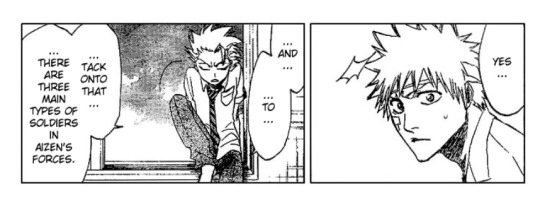

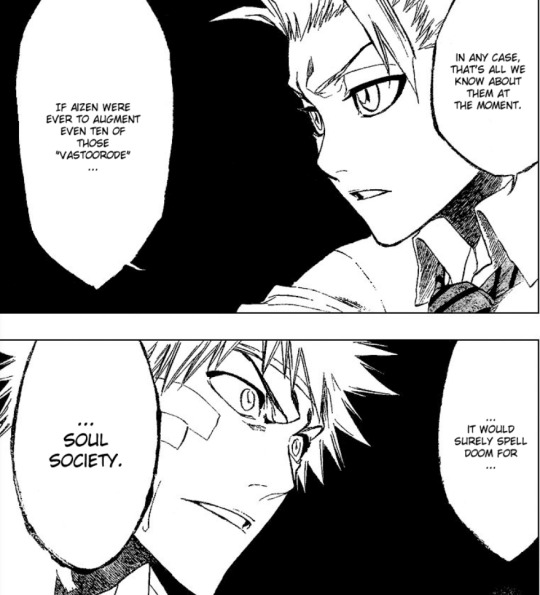
Notice now in Chapter 197: The approaching danger, Kubo uses a gradual zoom to build tension and the black background to add intensity and signal to the reader that Hitsugaya is relaying important information.
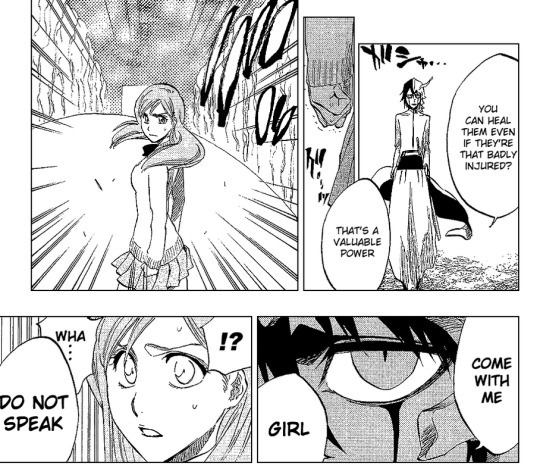
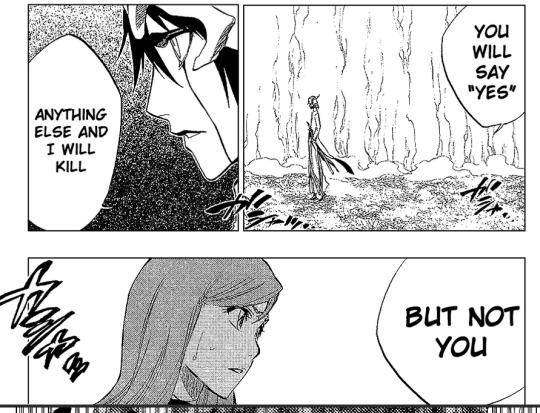
Here in Chapter 234: Not Negotiation, the immediate close up to Ulquiorra’s eye from the full body shots creates a sense of intimidation and unease with its sudden intimacy. As well, the immediate zoom in from Ulquiorra’s side full body shot to his facial profile creates tension and the change from the dark background to the white face with Orihime releases this tension (very fitting with considering the line for this panel is “but not you”). (This scene also ties into Ulquiorra’s central dogma of “that which is not reflected in my eyes does not exist’.)

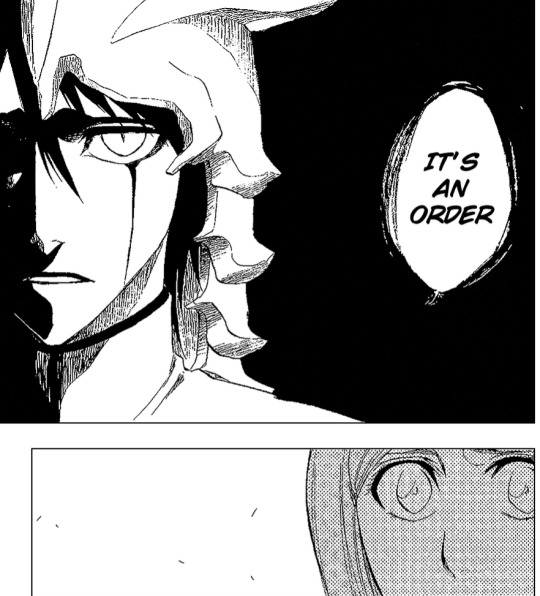
Again in the same chapter, this gradual zoom in on the two creates tension that is then release in the next panel and summarily cements Ulquiorra as a terrifying BAMF.
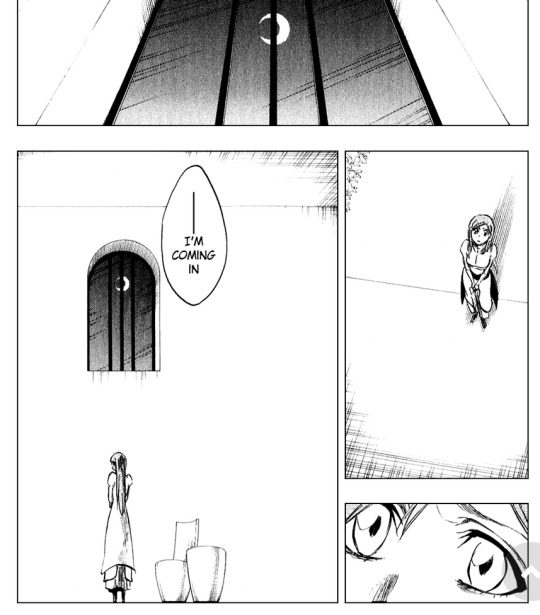
In Chapter 262: Unblendable, Kubo uses the negative space to create a feeling of isolation, similar to how Orihime is supposed to be feeling.
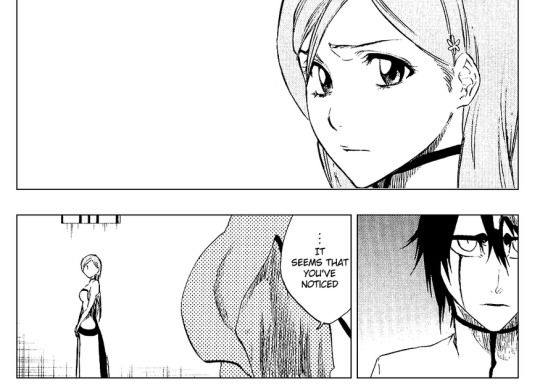

In the same chapter, notice how Kubo creates a sense of intimacy (not in the romance sense) with the relationship of Ulquiorra and Orihime. He creates tension gradually with the zooming into Orihime’s eye and releases it with the zoom out to Ulquiorra. Through this scene, Kubo has shown us that Ulquiorra and Orihime have a tense relationship and with the implication of eye contact through the shots and panel breaks creating both the intimacy and showing Orihime’s defiance.
(Interestingly, I’ve noticed that Ulquiorra and Orihime have a lot of these intimate zoom shot-reverse-shot eye panels)
___________________
What are the Bad Parts of Bleach?
Okay, so by now, you’re probably thinking that I’m ignoring the massive amounts of critique that Bleach gets and don’t get me wrong, while Bleach does have a very special place in my heart, I’m also not maudlin enough to pretend that Bleach was all good.
Pacing:
Pacing in the First Half of Bleach (Karakura Town - Arrancar)
When Bleach first started out the pacing was excellent. Kubo showed great mastery of pace to control the tone and highlight the emotions throughout the first two arcs. Mid-way through the Arrancar arc, the fatigue sets in and it was hard to keep up with, especially since Kubo would interrupt one exciting fight set up to go set up more plot elsewhere (eg Fake Karakura town right as Ichigo and Ulquiorra were about to battle). Whilst looking back and reading it all at once does help with the pacing, it was frustrating if you were reading/watching on a weekly basis.
Pacing in the Anime:
I don’t ascribe to a simplistic belief of “fillers bad” simply because I think that sometimes fillers can be a good thing, for example, since every chapter is ~15-20pp, some character interactions have to be cut for the sake for space, so filler is a great opportunity to add those moments back into your story. For example, a lot of early Bleach fillers are just the people of Karakura town just hanging out. That being said, Bleach does have an unfortunate amount of fillers, with some of them even interrupting tense fights (eg the Beast Sword Arc interrupts Ichigo’s battle with Ulquiorra). However, the padding that the fillers provided did wonders for the transition between Soul Society to Arrancar Arc in the anime. Ultimately, the Bleach anime adaption was a long-running anime made for syndication and that’s okay.
******* Brief Aside: many people like(d?) to point out that Bleach has a very cyclical plot structure. I used to think this way too; however, this is not the case. There are many other long running stories that repeat similar goals. The problem lies not in the idea, but the execution. The main complaint about the Orihime rescue was not that it was uninteresting, but instead that it felt a rehash of the plot of the previous arc. This is largely because the story was not given enough time to breath between similar character arcs. For example, in One Piece, Luffy and Co have to save Nami and by extension, her home village so she can join them; however, the next time a Straw Hat needs to be saved is 227 chapters (2 whole story arcs) later. In between saving Rukia and Orihime, there is only a really an arrancar encounter, a bit of training, cheering up Ichigo, and a Grimmjow encounter before Orihime goes with Ulquiorra, thus making the goal of this arc “save Orihime” in only ~59 chapters vs 227. These two similar arc goals so close to each other does indeed create the sense of repetition.
Pacing from Fullbringer to End:
This is where Bleach really lost a lot of people. If you weren’t gone after the Ulquiorra fight, you probably were by this arc.This arc went at breakneck speed, and ngl, during my first full read through I almost gave up here too. I mention earlier that Ichigo had been broken down in this arc, but it was hard to feel his despair and the weight on his shoulders because there wasn’t enough for the reader to take a beat and breathe. The Thousand Year Blood War, similarly suffered from sloppy pacing, with many readers feeling like story lines of Squad 0 and the Soul King were anti-climactic. As well, this arc started with a massacre and feature the deaths of many fan-favourite characters, and unfortunately due to the pacing, their deaths were not given a sense of gravity.
Missed Opportunities and Forgotten Story lines: Many people felt that Kubo forgot about a lot of his characters after the Aizen arc. Many thought the Fullbringer Arc was going to be a Chad/Orihime Arc. Whatever happened to Uryuu lolol? We all just collectively forgot about him for a large portion of the last half of Bleach. At one point in time, there was a rumour going around that Kubo had written out the story for Bleach and lost it. Idk if there is any credibility to it. However, in a 2017 interview, Kubo did say that he did end the series exactly the way he wanted to.
(If anyone wants to see me write an entire ass text post about Orihime and her treatment in Bleach, please let me know because I will do it)
Too mature:Even though above, I praised Bleach's mature handle on its themes, an unfortunate side effect of this is forgetting that the characters are only 15 at the beginning and for the first half of Bleach. This unfortunately, leads to some readers feeling disconnected from Bleach.
Epilogue: THE DESTROYER OF SHIPS!!! A lot of people hated this ending. Many people felt like the romance was shoe-horned in, others didn’t like the pairings, and there were some people who actually liked it. Personally, I didn’t like it too much, but it was a cute conclusion nonetheless. Since it didn't add anything to the story except for a "where are they now" look and because of that, I low-key felt like it was unnecessary, but w/e.
------------------------
Perspective
Making a long-running weekly serialized story is hard and doing it for 15 years is gruelling (obligatory “fuck capitalism” here). Like many artists of long-running manga, Kubo destroyed his health for the sake of publishing Bleach weekly. Kubo on his health after Bleach (photo from AshitanoGin on Twitter):
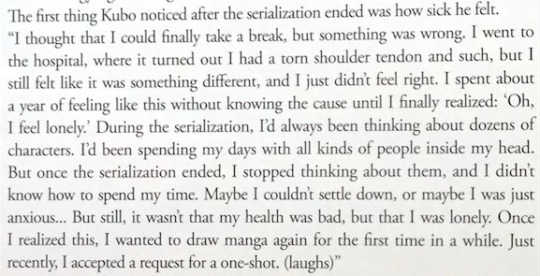
Given this insight, I think it’s only fair to be respectful and grateful for Kubo’s contribution to the anime-sphere. Also, through his work, Kubo seems to be a very understanding person and artist. I’m sure he knows better than anyone where Bleach went wrong, but there’s nothing that can be done now. Despite him having a twitter, he is not Joanne and doesn’t feel the need to constantly hemorrhage out word of god info about Bleach (and thank god for that).
------------------
Final Thoughts
It’s hard to forget my happy memories when I think about Bleach. It had my first adolescent crush and first OTP. As a result, I think the best way to enjoy Bleach is to take what you want out of it. People always think that something has to be 100% without flaw for it to be good, but that is not true at all. It is totally okay to just like the parts that you like without engaging with anything else. It’s special to you for a reason, you know?
There’s no use in fretting over what Bleach could’ve been, besides, very rarely is the reality better than the fantasy in your head.
I do think though that a lot of Kubo’s issues could’ve been fixed if he planned the story better but not all of us can be “I've been planning One Piece since elementary school” Oda Eiichiro.
Other voices on this issue: here
----------------------------
Wow. I can’t believe you made it this far down. Congratulations! Thanks for reading my 2:30am non-sober take on Bleach (it only took me 7 hours to write). Here's a cookie <3
#bleach#pro bleach#analysis#writing#characters#ramblings#pro orihime#orihime#ichigo#ulquiorra cifer#hot take#quarantine thoughts#late night#weebshit#criticism#critique#anime review#manga#i'm still bleach
53 notes
·
View notes
Text
Francoise Gilot painted “Adam Forcing Eve to Eat An Apple” in 1946, the year she moved in with Picasso to become his young muse. In a New York Times article, Alexandra Schwartz quotes Gilot saying that this is no accident. The painting depicts a woman looking at the viewer with an apple forced into her mouth by an angry man with furrowed brows, and the Biblical title implies a sense of lost innocence and hindsight realization of her own unfortunate situation. The description of a “forced” act calls to mind descriptions of sexual assault, a nonconsensual penetration. Gilot is keenly aware of this connection, as she compares Picasso to the monstrous pirate Bluebeard, who
… didn’t cut the heads [of his wives] completely off… he preferred to have life go on and to have all those women who shared his life at one moment or another still letting out little peeps and cries of joy or pain and making a few gestures like disjointed dolls, just to prove that there was some life left in them, that it hung by a thread, and that he held the other end of the thread. (Schwartz)
Gilot clearly delineates the emotionally manipulative tactics that Picasso used, with his desire to keep all his women at arm’s length. Her description of him keeping his muses “hung by a thread” (Schwartz), which he holds in his hand, shows the way Picasso treated her and others as doll-like objects that he could use however and whenever he wanted, and that he had a sense of entitlement towards their bodies, due to a successful career and an inflated career. Even today Picasso is cited as one of the most famous artists in the world, with Guernica and Weeping Woman being some of his most well-known. It is worth noting that Francoise Gilot was a painter in her own right, and she became a muse in an effort to make connections within the art world that would improve her own career by association. She expected that working with Picasso would bring her artistic opportunities, though likely did not expect the mistreatment she received. And yet she is not famous. The tradition of the muse is named after the Greek goddesses who blessed men with inspiration, but it is most famously used referring to the women who posed for portraits, dating back to the Renaissance when classical-style realistic paintings came back into fashion. The essay “Sexual Violence: Baroque to Surrealist” by John Loughery claims that the proliferation of nearly-nude women in Renaissance painting, so ubiquitous in art museums, comes from a more sinister tradition, describing that the paintings “speak volumes about the power factor inherent in the post-Renaissance tradition of the female nude, and, with their riveting straightforward glance, they point ahead to Manet’s Olympia, Zola’s Nana, and an avalanche of prose and imagery that affirms women’s comfort with their own sexuality, or male projections about that level of comfort” (Loughery 299). This essay sees these centuries-old masterpieces not as ethereal works of art that transcend sexuality, but as works of pornography that were designed to titillate the viewer and bypass the highly religious era they came from with their classical setting. Putting aside the oil brushstrokes, Edouard Manet-- and Pablo Picasso-- are simply depicting the nude body of a young woman. While in many cases this situation may have been consensual, Loughery claims that it would be hard to put aside the inherent power dynamic. Like a high-ranking executive of a film company taking advantage of a young woman, a famous and well-connected artist would certainly hold sway over an ambitious young girl. It would be hard to ignore the age difference between the muse and the artist, the often married man and the often-underage ingenue. Also, the idea that “male projections about that level of comfort” discounts the assumption that the women involved would be comfortable with her depiction. Women are often expected to be beautiful and available, Andrea Pino-Silva argues in the essay “I Believe You, Como Eres”, with their “success determined by the boys we charmed at our quinceaneras, of the lengths we took to prepare ourselves to be wives (Pino-Silva)”. There is a clear gender division, visible in every situation from a muse sitting for a portrait to a girl in a ball gown at a quinceanera. The man is expected to have power, he is masculine, the one who asks the girl to dance, the one who moves his model into the position he wants to paint. The woman is just beautiful and must work to keep herself that way. Not only can the artist use his own power and position to take advantage of the muse, he can choose to make her appear however he wants, like a posable doll-- he can make her look like she deserves whatever attention she gets.
Nowadays, the world of artist-and-muse shows itself differently, as the prominent art forms have shifted with time. The familiar story of a man exploiting a woman for creative gain is now most often associated with the film industry, in particular with director Harvey Weinstein and his actress victims. In the case of Weinstein, this is put in a very sinister light with Salma Hayek, who wanted to star in a movie about the artist Frida Kahlo but was forced to include sexual scenes in order to appease Weinstein’s own sexual desires. The muse and the model are very similar, in age and in public perception-- being a beautiful woman paid to look good and inspire works of art. One such model/muse is Kaori, a sitter for the Japanese photographer Araki Hirohiko. During the time of the #MeToo Movement in 2018 and 2019, when millions of women came out with their stories of sexual harassment and assault, Kaori told her story to the New York Times, describing how the photographer emotionally abused her. She describes Araki as treating her “like an object (Kaori)”, when “he asked [her] to do abnormal things, and [she] did them as though they were normal. (Kaori)” Kaori described an incident in which the photographer took nude photos of her, and then published and distributed them without her permission, as described within the New York Times article . It is clear that Araki has taken advantage of his position of power, both as an elderly man in a patriarchal Japanese culture, and in his successful career as an artist allowing him to take liberties with the normal steps of asking for permission and consulting her. This is an extremely similar scenario to Salma Hayek’s experience with Harvey Weinstein, as along with his sexual harassment, Hayek endured extreme emotional abuse. Hayek states in her op-ed for the New York Times that “the range of his persuasion tactics went from sweet-talking me to that one time when, in an attack of fury, he said the terrifying words, ‘I will kill you, don’t think I can’t.’” Like Picasso pushing the apple into Gilot’s mouth, and treating her like a poseable doll rather than a real woman, Kaori and Hayek face emotional abuse from creative men. In fact, the distribution of Kaori’s images could be compared to revenge porn, in which images that have been captured with consent of the body depicted are released without permission, usually for spiteful reasons. Revenge porn is considered a Class A misdemeanor in many states and is considered a form of sexual harassment. The fact that this is such a widespread problem, to the extent where it has been banned by Ireland, shows that the idea of distributing non-consensual nude images has evolved far beyond the Victorian boudoir images of young women resting in nothing but a necklace-- the “male projections about level of comfort” that Loughery mentioned, where male pleasure in viewing a woman’s body is more important than her own comfort and consent.
Women throughout history are often disbelieved, ignored, and left to their own anger and rage. Francoise Gilot channeled her anger into her own Cubist paintings, following a tradition started by Artemisia Gentileschi among other underappreciated female artists who suffered from sexual abuse. Gentileschi is best known for the iconic painting Judith Beheading Holofernes, another example of a Biblical motif being used to convey another meaning. In this image, Judith is bent over the man’s helpless body, her sleeves rolled up over her elbows. muscles outstretched to drag the sword through his neck. Blood spurts out gorily, as Judith is attended by her maidservant. Though the woman in the painting is Judith, it is likely Gentileschi as well-- a woman who was raped by her father’s friend as a teenager, and who was subjected to a humiliating rape trial, according to John Loughery’s essay. The story of Artemisia Gentileschi’s life shows how little her life differs from that of a modern-day rape victim, although Judith was finished in 1621. The painting becomes a revenge fantasy, a way for Gentileschi to release her pent-up rage, visible catharsis as Holofernes becomes her rapist, and her maidservant holding the basket for his severed head becomes a metaphor for the women who unite over a shared enemy. Pablo Picasso and Gentileschi’s rapist were both artists who took advantage of their success and power, in addition to their position as creative men-- as art has been considered a feminine pursuit, creative men may compensate for their choice of career by acting with masculine bravado. Rebecca Solnit writes about the patriarchy’s discomfort with women, and desire to erase feminine attributes among men.
If emotion must be killed, this is work that can make women targets. Less decent men hunt out vulnerability, because if being a man means learning to hate vulnerability, then you hate it in yourself and in the gender that has been carrying it for you. Girl and pussy have long been key insults used against boys and men, along with gay and faggot; a man must not be a woman. (Solnit 30)
16 notes
·
View notes
Text
Thoughts on Fruits Basket 2019 2nd Season Ep24 [”Here You Are“]:
Even though this wasn’t as comedy-focused as last week’s episode, things continue to be relatively chill and relaxed.
Just because there’s still one more episode left of this season and we’re almost exactly two thirds of the way into the overall story doesn’t mean things won’t suddenly and drastically change next week, right? :)))
Anyway, thoughts under the cut.
I mentioned this last week since the next episode preview confirmed it, but they really did skip the whole Kyoko backstory arc, in order to jump straight ahead and adapt chapters 94 and 95 in this episode.
I still think this will work out fine in the end, though. It’s pretty obvious at this point how they’re going to end season 2, and it’ll be appropriately climactic. They’ll probably just revisit Kyoko’s backstory later on when it comes up again, which will hopefully flow nicely and not feel too much like a lengthy detour in the story or anything.
Either way, this episode continues the recent focus on Yuki and Yuki-related plot points by being about Machi, and then the New Years stuff.
In spite of the fact that I’m really not a fan of the Yuki/Machi ship, I honestly still really like Machi as a character, and the first half of this episode where we get our first proper look into her thoughts and her life really go to show why. My whole family and upbringing situation was very different to hers, but her whole depressed mood and how it impacts her self-perception and how she carries herself in general is one of the more relatable parts of the whole series. The art and cinematography in her scenes was also really good at getting across the whole mood of the scene.
But ultimately I still feel like as a character she suffers too much from coming into focus way too late in the story, at almost the exact same time that other plot stuff starts kicking into high gear and there’s no time to really focus on her anymore, so she gets a handful of very concentrated, heavy moments to establish her entire character arc and her relationship with Yuki, and compared to the more long-form storytelling that the rest of the series displays, it just ends up feeling kinda artificial. And even though I do really like her as a character, and I do relate a lot to her, her and Kakeru’s whole backstory almost feels like a parody of Fruits Basket as a whole, and the fact that it’s delivered so quickly and barely delved into doesn’t really help that impression. Like I said last time, Kakeru at least benefits a lot from having been woven into the story a lot since a fair while ago, whereas for a variety of reasons Machi has largely been kept in the background until this episode.
I wasn’t really planning to go into full detail just yet about why I don’t like Yuki and Machi’s relationship [which is a more or less separate issue to Machi’s character in and of itself and how she’s handled in the story], but I think this episode alone pretty much summed it all up, especially going by how people are already reacting to it.
Basically I just really don’t like how aggressively the story wants you to realize how Yuki and Machi’s whole relationship is basically just a parallel to Tohru and Yuki’s relationship. It’s so heavy-handed that it just takes me out of the story, and the fact that they’re intentionally drawing that comparison feels like it actively goes against a big part of what Yuki’s recent development has been about.
When Yuki was opening up to Kakeru about all his feelings toward Tohru, he made it clear that he actively disliked the idea of that sort of dynamic developing into a romance, because it was so fundamentally unbalanced and one-sided that it would make him feel even more lonely. He didn’t want to be on the receiving end of a mostly one-sided flow of emotional support, so I just can’t help but dislike how it feels like his relationship with Machi is almost exactly the same thing, but this time it’s Yuki who’s providing the support.
It’s not like Machi doesn’t provide anything for Yuki emotionally, but it’s also not like Yuki didn’t provide anything emotionally for Tohru either. It was just a *mostly* one-sided and unbalanced dynamic, and I feel like the same thing applies here.
I just feel like, going by his own whole speech about his feelings and what type of relationship he wants, I’d want him to get a romantic partner who he feels more ‘equal’ with, in a sense. Someone who doesn’t just receive his support, or who just treats him normally, but someone who pushes him to be a better person, and forces him outside of his comfort zone in a way that helps him grow.
Basically this is just an elaborate way of me saying that I ship him and Kakeru, lol.
And honestly I don’t even dislike the core concept of Yuki and Machi’s relationship, I just don’t like that it goes in a romantic direction, since it feels like it happens with the exact same reasoning as why Yuki said he didn’t want a romantic relationship with Tohru. I really do like the idea of him being able to grow enough as a person to help someone else [even if the story really isn’t subtle about how Machi is almost exactly like how Yuki used to be, lol], but I’d just prefer that to play out in a more platonic way.
Plus, from a slightly different angle, I also don’t really like the idea of Machi getting into a romantic relationship where it feels like she’s mostly just on the receiving end of emotional support, for basically the same reasons why Yuki said he didn’t want that for himself. I think she also deserves better than that.
But to be honest an unavoidable part of the whole problem is also just that we barely even get to see what their relationship is actually like in practice, and we pretty much just see the part where it’s like ‘wow, they’re JUST LIKE how Tohru and Yuki used to be!’, and we just have to kinda guess at how things play out for them after that. Which is yet another reason why I think she really suffers from being focused on so late into the story, lol. It’s entirely possible that if we actually got to see how their relationship evolved I’d be more on board with it, but we only see a fairly small portion of it in the end, so that’s what I’m basing all my thoughts on.
[Also there’s the whole separate but related topic of how I still think it’s disappointing how Yuki’s whole struggle about feeling unable to love Tohru romantically, and feeling socially obligated to perform normative heterosexuality with her is just followed up by him finding a different girl to have as a love interest, but I could make another whole post about that so whatever]
ANYWAY, that was a whole bunch of opinions I’ve been sitting on for a long time now, lol. Even though I kinda don’t care much about Yuki as a character in a vacuum, I feel very strongly about the way his character arc plays out, and all the writing surrounding him.
That aside, the rest of the episode was just about the New Years banquet and getting some glimpses at most of the zodiac members to start setting the scene for the final third of the story. The transition between the two halves of the episode felt super abrupt and jarring, and you could really tell that it was jumping from one chapter of the manga to the next, but still, I liked the second half a lot.
There’s a lot of different moments with different characters, but I really liked seeing more of Tohru and Kyo. By this point it’s really obvious how they’re settling into a comfortable groove with each other, even if they aren’t exactly open about their feelings yet. I think it’s really neat to see how their relationship has slowly but surely been changing and progressing across the course of this season, without them even being entirely aware of it. This season as a whole might have been largely Yuki-focused, but Tohru and Kyo have come a long way with their relationship since the end of season 1.
Also, I think this is literally the only time we’re gonna see Ritsu in season 2 outside of the OP/EDs, which is kinda depressing, lol. I really hope they can come up with some original content in season 3 to give him some screen-time, but at this point I’m not getting my hopes up.
And even though this episode is mostly pretty laid back, the scene with Yuki and Akito really does set up for the next episode, and how things in general are about to come to a head and fall apart.
I’m curious to see exactly where they end the next episode, since they might decide to end it only partway into chapter 97, instead of going all the way to the end. But at this point I think they’re probably gonna go all the way up to that big cliffhanger, and we’re all just gonna have to wait like 6+ months for the anime to continue from that, lol. If they go that far with the next episode, then I’m definitely curious to see how anime-only people react to it, for better or worse.
15 notes
·
View notes
Text
ace of diamond (season 1) review

Hey there! I have recently finished the first season of Ace of Diamond and I’m going to be reviewing on five categories: plot/pacing, characterization/relationships, voice acting, art and OST. Aaaand because of how much I enjoyed it, I’m going to throw in my favorite character, dynamic and OP/ED. At the end I’ll be adding rewatchability/recc score.
Genre: Shonen / Sports
Subgenres: Comedy / Slice of Life / School
Synopsis: Sawamura Eijun is a unique southpaw pitcher from a small town in Nagano with a lot of potential but unpolished skills. After being scouted to play for Seidou High School (a prestigous baseball school in Tokyo) he is encouraged by his friends and family to go and accept the offer and pursue his passion for baseball at a higher level. Confident to the point of arrogant, he declares that he will be the ace pitcher on this new team and be the best -- but has to grapple with the fact he is surrounded now by extremely powerful, talented players who have been honing their skills for years-- some of whom are better than him, like his rival Furuya Satoru, a pitcher with a wicked fastball. Together, this team aims to be the best in Japan and aim for the Summer Koshien, tackling formidable teams who stand in their way--as well as work on their own goals, dreams, fears and insecurities.
Plot & pacing: The pacing of this show is very well done. In a 75 episode first season, it is rather long, with many of the baseball games drawn out. But its well worth it, as the writing brings a lot of emotional gratification by “feeling what they feel.” Starting with Sawamura being scouted, going through intense spring training and the selection of the summer starting roster, throughout the highs and lows of the summer season and into the post-summer scrimmages and finally rounding out the season with the third-year retirement game before the fall tournament raffle, every bit is given important narrative attention.
The reveal of information through the eyes of the protagonist; not knowing about Chris Yuu Takagawa’s injury until Sawamura knows it, not knowing how much the current third years sucked as players until the right moment through flashbacks during the tipping point of the finals game, for example -- is such an important choice that we as an audience feel what he feels. The summer games feel very high stakes, the emotional impact is well-earned; every victory feels like it was earned and not given through plot armor or well ~obviously Seidou is the protagonist team, they have to win.~ Seidou as a team was written as strong but not invincible. SPOILER: This is emphasized at the finals game against Inashiro. Despite losing, while emotionally devastating, it feels like it was a logical writing choice and will be important growth for not just Sawamura but the team as a whole.
The yips arc that follows the loss wraps up in a very wholesome retirement game, with Sawamura not fully recovering, but beginning to do truly do so, and the hopeful note of beginning the fall tournament, leaving the audience ready and excited for more.
As a side note, Ace of Diamond very beautifully balances comedy to drama, so it takes itself seriously but is also genuinely comedic. I have two running jokes of “fellas, is it gay to x” and “screenshot of out context being x” as well as actually laughing over some of the planned jokes. But it is truly an emotional carthartic journey.
[Did I cry? yes. so much.]
characterization & relationships: All of the characters feel very well-rounded with diverse ethnic and social backgrounds and personality traits. Some may be static but many of them experience growth to become better people and players. Sawamura is a good “bouncing board” of a character, as someone who goes from arrogant to experiencing several setbacks and a devastating loss that makes him examine his own biases, weaknesses and flaws that also reveals to his opponents their own shortcomings. Several other characters are better players than him, and that’s okay. On the flipside, one of the canon examinations as well as audience reaction is that Coach Kataoka has a team who is a family, a well-oiled machine who works amazingly together because they trust and care for one another, that he encourages growth and inspires them to be the best not just as baseball players, but as individuals as well. The opposing teams are also not just blank slates to fight against, but thoughtful people with their own desires, backgrounds and flaws--Mei Narumiya is cocky and unable to handle criticism once put on a pedestal, Sanada Shunpei has low stamina, etc etc.
Something that’s extremely important to reemphasize is the relationship the Seidou team has to one another in that everyone affects everyone else. Sawamura chooses to go to Seidou specifically because Miyuki Kazuya, a first year at the time, encouraged him to pitch, so he had one upperclassman who already believed in him by the time he enrolled. Sawamura has both batchmates (first years Furuya Satoru and Haruichi Kominato) that encourage him through rivalry (Furuya) or gentle friendship (Haruichi) and several upperclassmen he admires and multiple times states he adores this team as it is, because he looks up to them for guidance and inspiration-- quiet team captain Tetsuya Yuuki, loud outfielder Isashiki Jun (the namesake of this blog, “the spitz of seidou”), speed demons Ryousuke Kominato and Youichi Kuramochi, and more.
In particular, he has an exchange of growth with Chris Yuu Takagawa, someone he mistook for being uncaring and hopeless about baseball with a dead-eyed appearance. Chris, after being injured, all but had given up on playing again, but Sawamura’s noisy and blunt personality who kept pushing him encouraged him to return to the field, and have hope again. Chris is a teacher that Sawamura then deeply respects and is there for him when he has the yips, returning the favor to help break him out his funk. The symbolism. *weeps*
Important to note also it that is isn’t just about Sawamura and the effect he has on them, but the relationships they have with each other. The Kominato brothers have their own relationship where Haruichi wants to be like his older brother; Isashiki may act wild and aggressive and cocky, but he is truly humbled by their team captain Tetsu; Miyuki and Chris met years before Seidou and that informs their dynamic and the kind of players they are today. This also extends to other teams; some have similarities like Akikawa Academy revering their pitcher Yang Shunchen and how that parallels with Seidou adoring Tanba even when he was out with an injury, and others juxtaposed with them i.e. how some players at Inashiro seem to resent the spotlight Mei receives or Shirakawa callously telling another player to kill himself.
I also wanted to note the way Coach Kataoka also sees his team; he is in many ways like a stern but loving father figure who wants the best out of his boys in every way, off and on the field. Other coaches seem to care more about money or fame than their wellbeing (Coach Todoroki or the replacement coach for Seidou), and others have different styles as coaches whether from pro experience or just age. It really emphasizes that it’s not just about the talent a team may or may not have, but how those players are nurtured as people.
(Favorite relationships: Chris & Sawamura, the Kominatos, Miyuki & Chris, .)
[Side note: if you care about shipping, this is a buffet, you’re going to have a great time.]
Voice Acting: The voices of this cast are spot on. Everyone’s voice seems to match their face and personalities and all of the voice actors give 110% to the character. The voices really make it for me, as I’m very particular about the sounds. It feels very realistic and the voices really make them seem like actual people and gives the audience a reason to invest. I’ve got nothing but praise for the voice actors and voice direction of this cast.
Art: I could go on and on about the art. The motion is very fluid, the backgrounds are amazing. The character designs are stunning and everyone feels unique and given thought. Style-wise it was very refreshing to see as a lot of modern anime I’ve been watching seems to have the stereotypical “2000s” feel, whereas Ace of Diamond feels like a gorgeous late nineties/early 2000s homage--fitting since, despite airing in 2013-2015, the manga originated in 2006 and it followed the art of the manga nicely. The color palettes are very beautiful and vibrant. I remarked more than once while watching it that it was clear that the artists cared for studying human anatomy, movement and realism (in comparison to how some battle shonen care more for looking cool.) The art is what drew me in to begin with and it never disappointed.
OST: I loved the OST so much. Frying-Pan did such an amazing job delivering gorgeous pieces of music. The beauty of it was just off the charts and went above and beyond to make fitting pieces for character themes, scenario specific pieces etc. Also the OPs by Tom H@ck and Glay were appropriately themed and got me pumped every time. I love the various endings also and their little character revealing bits. I like them all so much I never skipped them while watching.
[Favorite OP: Perfect Hero. Favorite ED: Cloud Nine. I listen to Cloud Nine literally every day.]
Can I rewatch? Absolutely! Even knowing what’s going to happen, the emotional journey is worth it.
Would I recommend? 10/10. Even if you don’t like sports, this is a great one. It was my first sports anime and it has set the bar so very high.
6 notes
·
View notes
Text
Bungo Stray Dogs Season 3 [Fifteen Arc] Theater Screening
Talk show with Bones Producer Suzuki, Kadokawa Producer Kurakane, Kadokawa Manga Editor Katou
2019 May 7
Cinema Sunshine, Ikebukuro
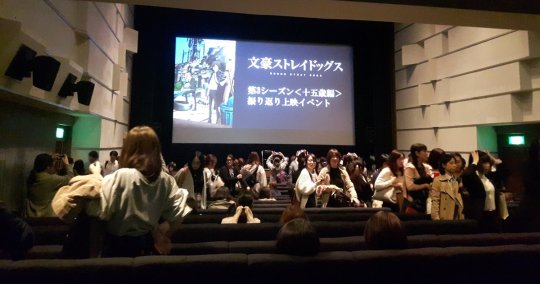
Sharing some bullet points that the staff talked about in the event:
Talks of having season 3 started around the time of the post-recording of Dead Apple. At that time, Fifteen had not been released so ofc it was not under consideration yet.
As has been revealed before, Asagiri-sensei was tasked to do only a 50-page bonus for the Dead Apple movie. He finished Fifteen first, and it ended up three times longer than what was asked, and though was really sorry about it, cannot make it shorter and turns out he is not actually good with writing short stories. BEAST even got longer than Fifteen, but in the end as the stories were really good, the bonuses were still given away as they are, now thick as books.
They started considering animating Fifteen when the 'higher-ups' (as in sensei, producers, scriptwriter, etc.) had a meeting together. In the end, scriptwriter Enokido wrote a draft which everybody liked.
The main point of animating Fifteen is that it helps build the world of Bungo Stray Dogs. By connecting the past and the present, it develops a deeper understanding of the characters, and also shows how the beloved city that Atsushi and the characters are now protecting came to be. Fifteen also showed the connection with the other canon material with Suribachi City, and Mukurotoride (Shibusawa’s base) in the background.
Animating Fifteen was planned to be a surprise to the fans, though a few days before the airing they learned that the information got leaked over twitter. This also happened back then with Dark Era, and Producer Kurakane shares that she was called by her boss regarding the incident. It went like, “This is the second time it failed, don’t you think there is no point in making it a surprise?” She said this just gave her the motivation to try harder to prevent the secret from getting spoiled next time.
The staff was really impressed with the voice acting, saying praises to Miyano, Taniyama, and Uchida-san. They thought it would be difficult but when they heard Mamo and Kishou doing the recording, it really gave them the feeling of how young Dazai and Chuuya were, and that these two really had a history. Furthermore, Randou only appeared in this arc but Uchida-san's acting was really memorable to them.
They think 15 yr old Dazai is different from today's Dazai, with 15 Dazai being really dark, and wanting to die for real.
From 15 to his present height, Chuuya only grows 5 cm 😅😅 He kept on saying, "I'll still grow!" but everybody (staff and fans alike) couldn't resist saying, "No, you won't" deep inside. (lol Chuuya we love you)
The staff was particularly glad seeing the last scene getting animated, as it came from the original manga. The art, especially with the stained glass, was also remarkable.
They also talked about the 3rd season’s OP and ED. Unlike the 1st and 2nd seasons’, the OP and ED for the 3rd season were specifically made to serve as a message of thanks to the fans. Instead of appealing to new fans of BSD, these OP and ED were made to express gratitude to the fans who have been here together with BSD’s journey. The scenes were meaningfully chosen and show what the characters have been through.
Producer Kurakane was particularly emotional with the ED and says that she tends to tear up watching it. She also pointed out that Atsushi and Akutagawa were singing in the ED.
Producer Suzuki adds that Dead Apple ended with the Armed Detective Agency door closing, while the season 3 ED ends with that door opening.
The staff is really grateful to the fans’ love and support, and they are really happy that BSD did not only end with one season of 12 episodes, but is now continuing with the 3rd season, and even extending to other platforms such as the movie and the stage play. Just like Dead Apple, treat season 3 as their present.

Once again, I felt the staff’s love and dedication to BSD, which makes you appreciate it more knowing that this is a work made by the staff and fans’ love. 😭😭
ANNOUNCEMENTS:
The full version of the Fifteen light novel will be released on August 1, featuring the cover, frontispiece, and other illustrations such as the character sheets by Harukawa-sensei.
Sequel for the Fifteen light novel entitled, "Bungo Stray Dogs: STORM BRINGER" is currently on the works and is to be released in 2020. "Dazai Osamu and Nakahara Chuuya. What will their chance meeting lead to?"
Everyone, please keep supporting Bungo Stray Dogs in any legal way you can!! And ofc spread the LOVE!! 💖💖
#thank you bsd for my life#i love you so much bsd staff#bungou stray dogs#soukoku#dazai osamu#nakahara chuuya#bsd fifteen#my original content
1K notes
·
View notes
Text
Elijah Post LFRP - Crystal data center

The Basics ––– –
Name: Elijah Post
Age: 28
Race: Midlander/Highlander
Gender: Cis Male
Sexuality: Gay (but flirts with pretty much everyone)
Relationship Status: Sort of involved? (He will neither confirm nor deny there being a presence of embarrassingly soft feelings...)
Languages: Common, a rudimentary grasp of Doman
Alignment: Chaotic Good
Physical Appearance ––– –
Hair: Honey Blond and could definitely use a cut or a style… or a brush most days, to be perfectly honest.
Eyes: Amber – more a reddish-orange hue than yellow
Height: 5’6”
Appearance: He is an attractive enough guy: excellent jaw line, straight nose, striking eyes, long limbs, trim figure, and a charming smile. Unfortunately (for anyone who has to look at him) his fashion sense is … questionable at best. Most of his outfits consist of brightly colored, egregiously wrinkled shirts and pants that rarely make it past his ankles. He wears a lot of tacky jewelry, sunglasses inside buildings and most certainly at night, and there is a very real possibility that the only footwear he owns, besides a pair of fluffy pink slippers, are sandals – which he has, in fact, been known to wear with socks. Still, he carries himself with a lazy confidence that somehow makes his perpetual “I have just woke up in the middle of the afternoon” look seem more of an artful affectation rather than a cry for help.
One of the more notable things about him are his plethora of scars, with the most prominent being the one that runs diagonal across his face and the two sets of whorling burns along both shoulders – one creeping down over his right pectoral and the other running over the upper part of his left arm. His ring finger on his left hand is missing after the first knuckle (don’t ask about this one if you’re eating), and a long surgical scar runs vertically along his outer right forearm. Underneath his clothes are a smattering of healed bullet wounds and a few others of less identifiable origin, but you’re gonna have to buy him a couple drinks if you want to take a closer look.
Personal ––– –

Profession: Journalist – specifically a freelance field correspondent who specializes in conflict journalism and investigative reporting. When he’s between field work, he often picks up puff pieces with local papers, writing about the arts, sports, culture, etc.
Residence: No permanent listed address – currently renting a room at the Hidden Pearl in the Mists. He can usually be found sitting at the bar after he’s just rolled out of bed, having bacon twists and sake for breakfast (at 2pm).
Birthplace: Ul’Dah
Religion: Meh
Likes: Day drinking, people watching, writing, sleeping, animals, (tall men)
Dislikes: Bureaucracy, wealth disparity, national pride, bullies, snobs, being cold
Fears: Commitment, being emotionally vulnerable, people in mascot costumes
Personality: Elijah seems like a pretty easy going, even tempered guy for the most part. He has a languorous, lackadaisical disposition – meandering through life as though he never really has a place to be, and if he did, he isn’t in any particular rush to get there. With friends or with strangers he’s quick to smile or laugh or tell a joke, affable enough that people tend to trust him with pieces of themselves without noticing he offers very little of himself in return. He can come across as flippant or indifferent in conversation, and while he is rarely intentionally cruel, he has a habit of jamming his thumbs into people’s buttons. It’s very possible he is just incidentally annoying rather than consciously so. He likes to maintain plausible deniability on that front.
When working in the field Elijah becomes much more focused – he stands taller, moves with purpose, exchanging his usual countenance of a rumpled layabout for that of a seasoned professional. He has on more than one occasion put his own body on the line (and in the hospital) in combat situations, or when pursuing a lead. He will recount each scar, and his half missing finger, with a joviality that some folks find off putting given some of the more grisly details. This disregard for his own safety is likely one of the (many) reasons he has never gotten a full time reporting gig with any of Eorza’s major newspapers – that, and he has a habit of leaving journalistic impartiality at the door. It’s clear from his writing that he has a deep well of empathy for other people and admires underdogs who fight uphill battles for high minded idealism, even if he ultimately believes their sentimentality to be a little bit naive..
Relationships ––– -
Parents: His Mother has passed, but his Father is still kicking and perpetually disappointed in his son! Their relationship is… strained by not estranged?
Pets: His Chocobo Bixley – but really, that’s more of a buddy and stalwart feathered compatriot than a pet.
traits ––– -
bold your character’s answer.
extroverted / in between / introverted
disorganized / in between / organized
close minded / in between / open minded
calm / in between / anxious
disagreeable / in between / agreeable
cautious / in between / reckless
patient / in between / impatient
outspoken / in between / reserved
leader / in between / follower
empathetic / in between / apathetic
optimistic / in between / pessimistic
traditional / in between / modern
hard-working / in between / lazy
cultured / in between / uncultured
loyal / in between / disloyal
Additional information ––– –
Smoking Habit: Has been known to chain smoke.
Drugs: The spice of life is trying anything and everything twice!
Alcohol: Probably too often on that front too..
Background information/ Potential RP Hooks? ––– –

UL’DAH BORN AND RAISED: He lived most of his youth in Ul’Dah, haunting the less affluent areas of Eorzea’s grandest pile of rocks in the desert. His mother was an Ala Mhigan immigrant and his father just a simple Ul’Dah native who ran a hole-in-the-wall restaurant. His parents were very “hard work and sacrifice” types when he was growing up, giving away free meals to refugees and anyone who was hungry. They were well liked by those who knew them, veritable pillars of the community, for whatever that was worth in what was hardly a half step above a slum. His mother died a few years ago but his father still works in his run down little restaurant – lots of folks still recognize Elijah as his parent’s kid rather than for his own work. He has mixed feelings about it.
FREELANCE JOURNALIST WITH AN AXE TO GRIND: Elijah’s had work published in The Mythril Eye, The Harbor Herald, and The Raven. Because he has a reasonably good standing at these newspapers (and friendly relationships with some of the editors) he’s able to pick up the odd puff piece, op-ed, or political coverage gig in order to cover his expenses when he’s between larger assignments. In the past he has written some pretty incendiary pieces about Ul’Dah’s treatment of Ala Mhigan refugees, as well as a few pieces lambasting the noble houses of Ishgard and their complacency in the Dragonsong War and their collaboration with the corrupt Holy See, which has earned him a bit of a “reputation”. On the other hand, he is just as willing to throw himself upon the altar of journalistic tripe for a quick gil. If you have any tips or story leads you want investigated, Elijah just might be your man. If your character is involved at any of the major Eorzean papers, they might be acquainted.
CONFLICT REPORTING: Elijah has spent time in the middle of political unrest in Ishgard, covering Garlean incursions and skirmishes across the continent, and until recently he has been covering the ongoing issues in Othard. In fact, he’s only just returned from spending an extended period living with the resistance forces in Gyr Abania; and, he has some very strong opinions regarding the absolutely hacking edits The Mythril Eye made to his work before publication (without his permission). If your character was part of the fighting in Gyr Abania, Elijah might have spoken to them or went out into the field with them on occasion.
TRAVELING FOR WORK: Given the nature of his job, Elijah has visited most major cities while on assignment and has been known to interview common folks, political figures, travelers, military types -- anyone who will talk to him. If you've spoken to him in the past, your words might have ended up in print, for better or for worse (he has been punched in the face on more than one occasion, and he regrets nothing); however, he has never once burned an informant or lead that has come to him for help. He has enough of a reputation that folks (government and law enforcement sorts) might take to actively avoiding him.
OOC/Contact Information ––– –
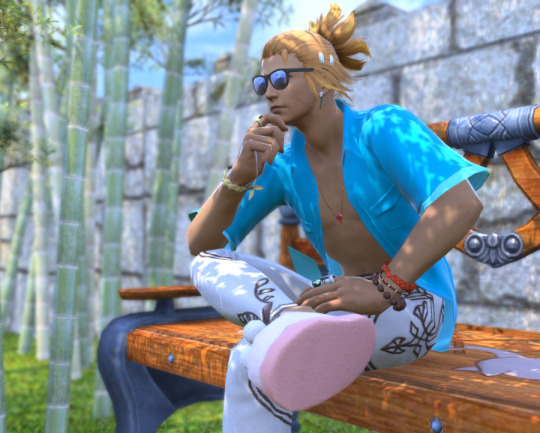
The Player: Becks | They/Them | 30+ | Atlantic Timezone | Canadian
Looking for: Long term rp connections, short term adventures, friendship, rivalry, romance, I’m open to pretty much anything!
I’m a 30+ year old player who is a little anxious and shy when it comes to meeting new people on the internet (hence playing an extrovert to drag me out of my shell) but I’m really excited to make new friends and rp connections!! As I said, I am up for anything, including walk ups when I am out and about, and this character is on the surface level a very chill and friendly dude! I am, however, also someone who engages with a lot of mature themes -- not just swearing, drugs and alcohol, but also heavier themes (the realities of class disparity and poverty, the human cost of war, trauma, etc etc) that might not be everyone’s cup of tea. But!! I wouldn’t just throw it out there willy nilly, and I believe firmly in communication between players -- discussing boundaries and limits is very important, as well as trusting each other enough to speak up if either party is uncomfortable!
I am cool with my character being injured, but please check in with me before doing anything drastic that will result in something permanent (like maiming or... y’know, death). Also I am open to rping romance (or lack of romance but the bits that go with it) though this character is currently not up for shipping adventures. Just to be clear, I am not comfortable doing that type of role play with anyone that’s under 25, sorry! I'm in my early thirties, and it would just be weird for me. We can still be pals, I promise!
Please only reach out to me if you are 18+ and your character is 18+ -- I am not comfortable interacting with minors.
All art on this tumblr is probably mine unless stated otherwise! <3
Contact: Message me here on tumblr, /tell Elijah Post on Balmung, and if we become friends I am up for discord handle sharing! :D
I am open to cross-world rp and rp outside of the game as well!!
Now that I’ve got this edited how I want it...
Boosts appreciated! Always looking for more active blogs to follow/be friends with!!
7 notes
·
View notes
Text
top books of 2020
I was tagged by @evies20dollars (thanks!) to name 10 of my favourite books I’ve read this year, so enjoy the list :) (Half of it looks like Tumblr 101 reading list, but nevermind.) I strongly recommend all of them!
- The Song of Achilles by Madeleine Miller -> retelling of the story of Achilles, romance & coming of age, beautifully written.
- The Picture of Dorian Gray by Oscar Wilde -> XIXth cent. English classic, also classic of gay lit. Blew my mind: awesome, also beautifully written and lots of talk about philosophy of life and art.
- Good Omens by Neil Gaiman & Terry Pratchett -> Comedy/urban fantasy. Good humour + I love the writing style.
- Radio silence by Alice Oseman -> YA, coming of age, mainly about friendship. Sad and somehow comforting at the same time.
- Loveless by Alice Oseman -> YA, coming of age, friendship, but also discovering (a)sexuality. Made me miss uni life so much...
- Dangerous Liaisons by Pierre Choderlos de Laclos -> XVIII cent. French epistolary novel, but really well written, especially with regard to psychological portrait of the characters. Lovers to enemies (!!!), romance, coming of age (but also sexual assaults etc). I actually have a whole post about it sitting in my drafts.
- Emma by Jane Austen -> XIX cent. English classic, romance, mutual pining (my favourite trope!), very funny.
- Year of the Flood by Margaret Atwood -> dystopian sci-fi, sequel to Oryx and Crake (one of my all time faves; Year of the Flood doesn’t beat it, sadly). Ecology, coming of age/maturing, kinda found family. A bit of romance.
- Jak przejąć kontrolę nad światem 2 (How to take control over the world 2) by Dorota Masłowska -> collection of essays and op-eds (it’s felieton in Polish, hope I got the translation correctly?) by one of the Polish contemporary writers, mainly about her travels last year and then observations about covid pandemic. I love her style, full of vivid and witty descriptions, although sometimes the descriptions are too exoticized.
- The War that Saved My Life by Kimberly Brubaker Bradley -> children’s book about an abused girl who is evacuated from London during WWII and it changes her life for the better. It was so sad, seriously made me cry, even though the ending is happy. Found family, healing froma trauma etc., some lgbtq+ representation (and also... classism?).
Honorary mentions of my fave books I’ve reread this year:
- The remains of the day by Kazuo Ishiguro (will i ever shut up about this book? No.)
- Baptism of Fire, Tower of the Swallow and Lady of the Lake from the Witcher Saga by Andrzej Sapkowski
- Wuthering Heights by Charlotte Bronte
- The Labirynth of Spirits by Carlos Ruiz Zafon
tagging @saint-dominik-of-zadar @princessaugustina and @elizabethelizabethh (if you want to ofc).
- you don’t have to list 10 books if you haven’t read that many
- honorary mentions are my own addition, so it’s up to you if you add them too
#tag game#reading list#i'm waiting to get some more books for christmas!#can't wait#also sorry it took me so long to make this list
3 notes
·
View notes